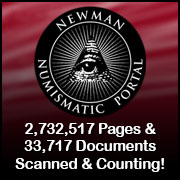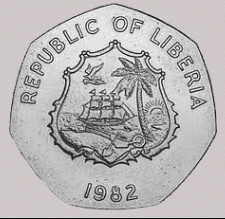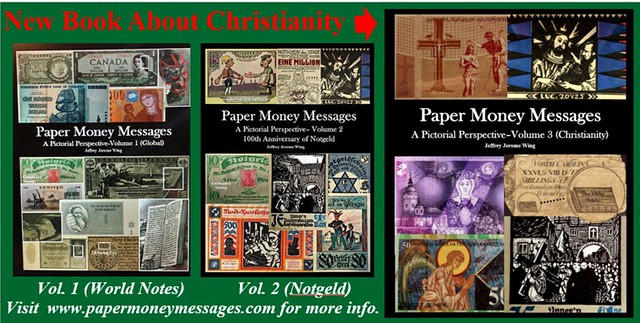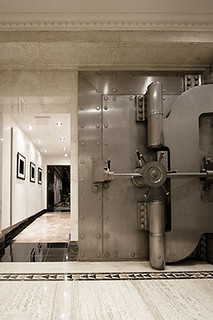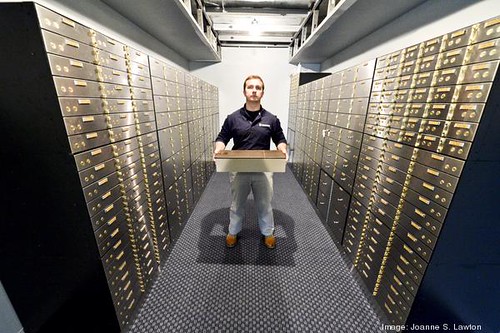
About UsThe Numismatic Bibliomania Society is a non-profit association devoted to the study and enjoyment of numismatic literature. For more information please see our web site at coinbooks.org SubscriptionsThose wishing to become new E-Sylum subscribers (or wishing to Unsubscribe) can go to the following web page link MembershipThere is a membership application available on the web site Membership Application To join, print the application and return it with your check to the address printed on the application. Print/Digital membership is $40 to addresses in the U.S., and $60 elsewhere. A digital-only membership is available for $25. For those without web access, write to: Charles Heck, Treasurer AsylumFor Asylum mailing address changes and other membership questions, contact Chuck at this email address: treasurer@coinbooks.org SubmissionsTo submit items for publication in The E-Sylum, write to the Editor at this address: whomren@gmail.com BUY THE BOOK BEFORE THE COINSale Calendar
|
- WAYNE'S WORDS: THE E-SYLUM NOVEMBER 24, 2019
- BIBLIOTALK: THE COIN BOOK LOVER PODCAST
- NUMISMATIC LITERATURE IN KüNKER ELIVE AUCTION 58
- TABULAR GUIDE TO UNITED STATES NATIONAL BANKS
- VIDEO: DAVID KIRK INVERVIEW
- NOTES FROM E-SYLUM READERS: NOVEMBER 24, 2019
- MORE ON SAFELY STORING BOOKS
- BILL FIVAZ TO SPEAK AT ANA NATIONAL MONEY SHOW
- VOCABULARY TERM: CONDITION
- HARRIET "HATTIE" P. ELLIS HAINES (1825-1903)
- OTTILIA BUERGER'S ANCIENT COIN COLLECTION
- CHIEF ENGRAVER JOSEPH MENNA
- COX 1838-O HALF DOLLAR FINDS NEW HOME
- 1943 BRONZE LINCOLN DISCOVERY CENTS UNITED
- SEDWICK NOVEMBER 2019 SALE RESULTS
- NUMISMATIC NUGGETS: NOVEMBER 24, 2019
- WAYNE'S NUMISMATIC DIARY NOVEMBER 24, 2019
- COINAGE OF THE GUPTAS
- DETECTORISTS CAUGHT TAKING ANGLO-SAXON HOARD
- VICTORIA GOLDEN JUBILEE GOLD MEDAL
- SMITHSONIAN EXHIBITS MCGRAW MEDAL OF HONOR
- CHINESE RUN FROM FALUN GONG OVERSTAMPED NOTE
- WHY DON'T WE HAVE A $25 BILL?
- THE COLLECTING BUG: TYPEWRITERS, MICKEY MOUSE
- LOOSE CHANGE: NOVEMBER 24, 2019
- NON-BANK FIRMS OFFER SAFE DEPOSIT SERVICES
Click here to access the complete archive a
Click here to unsubscribe (scroll down)
To comment or submit articles, reply to whomren@gmail.com
Content presented in The E-Sylum is not necessarily researched or independently fact-checked, and views expressed do not necessarily represent those of the Numismatic Bibliomania Society.
WAYNE'S WORDS: THE E-SYLUM NOVEMBER 24, 2019
 New subscribers this week include:
Clint Kucera, courtesy of Jim Ehlers; and
Bob Steinberg, courtesy of Steve Davis.
Welcome aboard! We now have 6,008 subscribers.
New subscribers this week include:
Clint Kucera, courtesy of Jim Ehlers; and
Bob Steinberg, courtesy of Steve Davis.
Welcome aboard! We now have 6,008 subscribers.
Thank you for reading The E-Sylum. If you enjoy it, please send me the email addresses of friends you think may enjoy it as well and I'll send them a subscription (but let me know if they are located in the European Union). Contact me at whomren@gmail.com anytime regarding your subscription, or questions, comments or suggestions about our content.
This week we open with a brand new NBS podcast, a numismatic literature sale, updates from the Newman Numismatic Portal, and notes from E-Sylum readers.
Other topics this week include the St. Louis Stamp & Coin Co., collector Ottilia Buerger, Chief Engraver Joseph Menna, the 1838-O half, 1943 bronze cents, coinage of the Guptas, Queen Victoria's Golden Jubilee medal, the $25 bill and safe deposit boxes.
To learn more about the Louisville vs. Lawrenceville dilemma, U.S. National Banks, the “Hookneck” silver 8 reales, safe storage for books, the Cherrypickers’ Guide , Harriet Haines, finger bars, explosive control tokens, plastic outgassing and the Noblemen and Gentleman's Catch Club, read on. Have a great week, everyone!
Wayne Homren
Editor, The E-Sylum
BIBLIOTALK: THE COIN BOOK LOVER PODCAST
As President Tom Harrison announced last week, the Numismatic Bibliomania Society has a new podcast, and the first episode is now available for listening. Check it out! It's available on the NBS web site but also on Apple Podcasts, Google Podcasts, Spotify, and elsewhere. -Editor
NBS Launches Bibliotalk: The Coin Book Lover Podcast
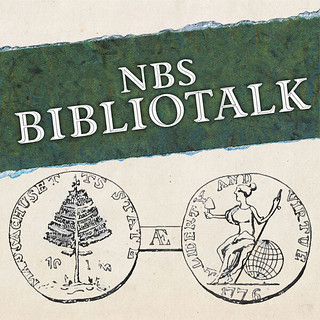 The NBS has launched a quarterly podcast, produced by Lianna Spurrier and available via the NBS website. Our first episode features Joel
Orosz describing his introduction to numismatic literature, and goes on to discuss various aspects of book preservation, storage, and
transport.
The NBS has launched a quarterly podcast, produced by Lianna Spurrier and available via the NBS website. Our first episode features Joel
Orosz describing his introduction to numismatic literature, and goes on to discuss various aspects of book preservation, storage, and
transport.
Along the way a few of our favorite (in some cases notorious) numismatic characters appear, with Orosz sharing personal recollections of several hobby figures. Joel further pontificates on the abiding and alliterative conundrum of all numismatic bibliophiles, that being the Louisville vs. Lawrenceville dilemma, in which coin book lovers are asked to cast their lot with either the best numismatic content or the best physical presentation. It’s an enjoyable hour, one that will make your commute fly by. Let us know what you think!
To listen to the podcast on the NBS home page, see:
https://www.coinbooks.org/
To read the earlier E-Sylum article, see:
ASYLUM WINTER 2019 ISSUE PUBLISHED
(https://www.coinbooks.org/v22/esylum_v22n46a02.html)

NUMISMATIC LITERATURE IN KüNKER ELIVE AUCTION 58
The Künker auction house in Germany is holding an online sale of numismatic literature. Here's their email announcement. -Editor
From now on, you can study all the pieces of the eLive Auction 58 - Numismatic Literature.
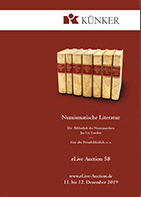 The auction contains more than 1,450 lots of numismatic literature from more than 400 years.
The auction contains more than 1,450 lots of numismatic literature from more than 400 years.
We present you a cross section of citation works, catalogs as well as basic scientific publications and special investigations, but also of popular and easy-to-understand representations, includes numerous sub-areas of numismatics of European, Oriental and overseas space. Among them are at favorable taxis and a number of convolutes. An extensive group this time offers the sector of medal literature.
Wednesday, December 11th, 2019 - 3 pm CET
Lots 4001–4704
Monographs, Collections and Essays:
- Bibliographies
- General Numismatics
- Classical Antiquity
- Middle Ages and Modern Times (up to Germany)
Thursday, December 12th, 2019 - 3 pm CET
Lots 4705–5406
Monographs, Collections and Essays:
- Modern age (from France)
- Medals
- Plaques
- Orders and Decorations
- Paper money
- History - General
- Arts and crafts
Commemorative Magazines and Series Auction catalogues and stock lists Congress and Research Reports History - General Coinage decrees
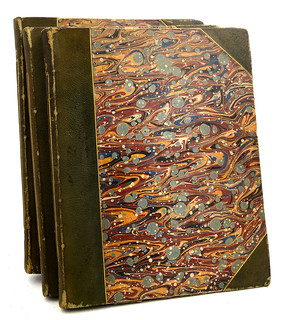
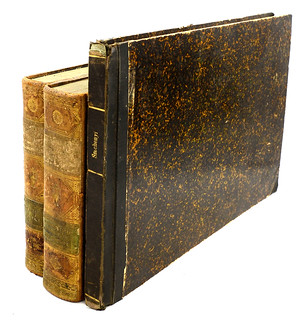
To access the catalog, see:
eLive Auction 58 Numismatic literature Part 1
(https://elive-auction.de/auktionen/76/lose?auction_section=1)
eLive Auction 58 Numismatic literature Part 2
(https://elive-auction.de/auktionen/76/lose?auction_section=2)

TABULAR GUIDE TO UNITED STATES NATIONAL BANKS
The latest addition to the Newman Numismatic Portal is Andrew Pollock’s Tabular Guide to United States National Banks. Project Coordinator Len Augsburger provided the following report. -Editor
Andrew Pollock’s New Publications on United States National Banks, 1863-1935
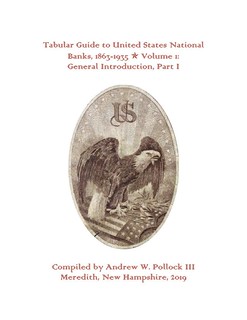 Andrew Pollock III continues his research of U.S. National Banks with a five-volume series, Tabular Guide to United States National Banks. The first three volumes are now available on Newman Portal and will be indispensable to anyone studying the currency emissions of these institutions.
Andrew Pollock III continues his research of U.S. National Banks with a five-volume series, Tabular Guide to United States National Banks. The first three volumes are now available on Newman Portal and will be indispensable to anyone studying the currency emissions of these institutions.
The first volume includes a bibliography for the series, to which Peter Huntoon contributed. The term “Bibliography” does not do the content justice, as this is actually a comprehensive and descriptive overview of the related literature.
Volumes two (Alabama to Montana) and three (Nebraska to Wyoming) provide a listing of the largest National Banks on a state and year-by-year basis. For each entry, Pollock cites the source, a welcome bit of information for readers who wish to dig more deeply into the subject. Pollock previously contributed datasets containing summary data for over 14,000 National Banks, and his work will no doubt be the standard reference for the foreseeable future.
Link to Andrew Pollock publications on Newman Portal:
https://nnp.wustl.edu/library/booksbyauthor/528054
VIDEO: DAVID KIRK INVERVIEW
These are selections from the David Lisot Video Library that feature news and personalities from the world of coin collecting. David has been attending coin conventions since 1972 and began videotaping in 1985. The Newman Numismatic Portal now lists all David’s videos on their website at:
https://nnp.wustl.edu/library/multimediadetail/522852
Here's an interview with David Kirk of Morton & Eden. -Editor
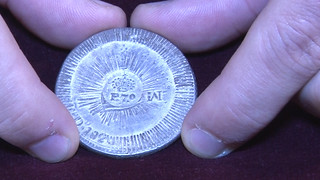 David Kirk, Morton & Eden, Numismatic Director, David Lisot, Interviewer, CoinTelevision.com.
David Kirk, Morton & Eden, Numismatic Director, David Lisot, Interviewer, CoinTelevision.com.
A first time appearance at the USMEX Coin Convention by London auction firm Morton & Eden to show the Mexico Collection to offered for sale November 14, 2019. Director David Kirk talks about the company Morton & Eden, being in Scottsdale for the first time, and highlights from their upcoming auction. Coins include an 1824 RL Durango countermarked Silver 8 Reales, a 1695 cob 4 escudo gold, an 1824 JM Durango “Hookneck” silver 8 reales, and a Mexico ½ real 1716 J Royal heart shaped.
This video is a highlight from:
US Mexican Numismatic Association Convention Highlights 2019
An excerpt of the video is available for viewing on the Coin Television YouTube Channel at:
https://youtu.be/9DLrcWIeo6A

NOTES FROM E-SYLUM READERS: NOVEMBER 24, 2019
The Baltimore Coin Flip Deal
In my Numismatic Diary last week I described an unusual coin deal I'd witnessed at the Northeast Numismatics table. Tom Caldwell provided the full background. -Editor
Tom writes:
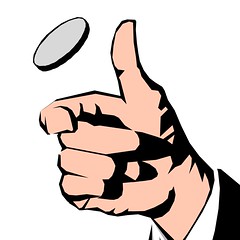 The way it went down was I gave my price at $11,000, the dealer offered $10,000 which in reality I would have taken. We then went back & forth & we discussed let's flip some increment around the $10,000 figure such as $8,000/$12000 or even double or nothing was thrown into the mix as a possibility. If this option was chosen one of us would get the coin for free & the other would pay $20,000.
The way it went down was I gave my price at $11,000, the dealer offered $10,000 which in reality I would have taken. We then went back & forth & we discussed let's flip some increment around the $10,000 figure such as $8,000/$12000 or even double or nothing was thrown into the mix as a possibility. If this option was chosen one of us would get the coin for free & the other would pay $20,000.
Deeming this option to really be not that friendly since it would be a major score for one of us & really painful financially for the the other, we ultimately decided to go with a more friendly $9,000/$11,000. A coin was flipped we called heads & heads it was. Northeast was paid the $11,000 & we then moved on the next deal. Gotta have a little fun once in awhile.
Feel lucky, punk? There's an element of randomness whenever prices are set, and there's something poetic about using a coin to decide the price of a coin deal. -Editor
To read the earlier E-Sylum article, see:
WAYNE'S NUMISMATIC DIARY: NOVEMBER 17, 2019 : Northeast Numismatics
(https://www.coinbooks.org/v22/esylum_v22n46a19.html)
To flip a virtual coin, see:
https://justflipacoin.com/
Correction: Liberia's Samuel Doe Served 1980-1990
Regarding a statement on last week's article about Liberian coinage
Pabitra Saha writes:
That must be a typo in the original publication. The coin is dated 1982, and Doe served from 1980 to 1990. -Editor
To read a Wikipedia article on Samuel Doe, see:
Samuel Doe
(https://en.wikipedia.org/wiki/Samuel_Doe)
To read the earlier E-Sylum article, see:
THE LIBERIA DOE COIN
(https://www.coinbooks.org/v22/esylum_v22n46a21.html)
Chinese Coins at the Smithsonian
Jerry Norton writes:
Although I don't collect foreign coins, I recently visited the vault at the Smithsonian National Museum of American History. I was amazed at the size and shape of the Chinese coins, given as a gift, located on the first floor at "The Value of Money" display! And it's free I might add.

To read the earlier E-Sylum article, see:
The Value of Money
(https://americanhistory.si.edu/exhibitions/value-money)
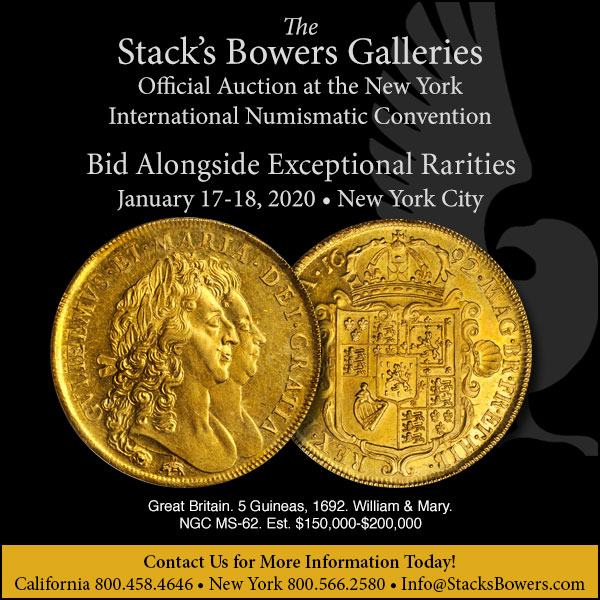
MORE ON SAFELY STORING BOOKS
Readers are chiming in with more thoughts and information on book storage (coin books or otherwise). First, Gil Parsons of Parsons Books. -Editor
The latest issue contained passing reference to using Ziploc® bags for book storage. My response is:”PLEASE DO NOT DO THIS!” Ziploc® bags are better than some, but are far from archival quality. The issue is the chemical composition of the bag: polypropylene is best (and itself has several grades); polyethylene is a significant grade below; polyvinyl chloride (PVC) is worst of all. Ziploc® bags differ materially from bags designed for preservation purposes.
I encourage readers to check out offerings by such as Gaylord Archival, Light Impressions, University Products, or other firms expressly dedicated to preservation. My first recommendation would be to wrap a worthy book in archival tissue, and then to place it in an appropriately sized archival cardboard box. But, if visibility be desired and plastic be deemed a desirable option, the (not excessive) investment in archival bags (which often can be had with sliding closures) is more than worthwhile.
A brief word about books in general: Approximately 1850 is the date of a “perfect storm” of book degradation: paper was made increasingly from wood pulp rather than from linen rags; ink became far more acidic as traditional materials (carbon black, oak gall, etc) were replaced by chemical compounds; many other adjustments were made to accommodate faster, powered, presses. Thus, these modern books degrade significantly faster than those of previous generations, which are often found as fresh as the day they left the press.
Older books are relatively inert, subject only to excessive moisture or too much direct light. Books of the late nineteenth (or even worse, twentieth century) will degrade regardless of what enclosure be used to surround them. And, as collectors have discovered to their chagrin in the context of recent Giclee prints or books produced by offset lithography, the degrading can occur even in total darkness and unencumbered air flow.
Ziploc® bags provide yet another opportunity for chemical interaction—Since they were only invented in the late 60s, I do not think there is adequate information of how they interact with various sorts of books and paper. One thing is certain: they are terrible for storage of photographic media. The production of “archival”products is more complex, and plastic “outgassing” is buffered or eliminated.
The discussion was triggered by Scott Semans' concern about dampness in his wet Seattle-area environment. He's storing a modern book inventory, not rare antiquarian works. But Gil's advice is right on target. We hadn't discussed this topic in a while and it's always worth revisiting.
Next is Bob Van Arsdell, who included links to two articles on book storage. -Editor
One mentions placing books in UNSEALED polyethylene bags - which may be controversial.
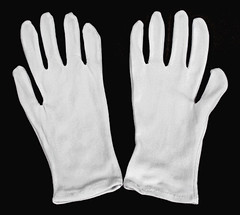 The other mentions using white cotton gloves, which certainly IS controversial. Gloves make people clumsy and more prone to damaging the pages. I find wearing gloves makes me very clumsy.
The other mentions using white cotton gloves, which certainly IS controversial. Gloves make people clumsy and more prone to damaging the pages. I find wearing gloves makes me very clumsy.
As always, someone will have an opinion on the internet. Frankly, I’m skeptical you’ll find a single source on the web that represents all the current thinking about book conservation.
For years, I believed that a good way to repair Victorian Era high-acid wood-pulp paper was to bleach it white and deacidify it. Then I met a young paper conservator who restored the worst paper imaginable to pristine flexibility, yet left the yellowing of age intact. It was an amazing experience to hold a Victorian cookbook with yellowed paper that should be crumbling to pieces and yet the paper was as flexible as the day it left the mill. Everything we think we know about book conservation is being challenged by modern techniques.
I was involved in developing an electro-optical instrument for measuring the thickness of plastic packaging materials 35 years ago. Ziplock-type bags are actually made up of 5 to 7 layers of different plastics. Two might be polyethylene to act as a moisture barrier. The innermost layer might be nylon, acting as an oxygen barrier. The other layers would be a kind of glue to bond the nylon to the polyethylene (they don’t stick together naturally). As you can see, this gets complicated pretty quickly.
Putting a book in a locking bag assumes you want to keep “bad” chemicals from entering or leaving the book. Remember, your dealing with chemical byproducts from deterioration of wood or rag paper building up inside a book. Maybe you really want those byproducts to dissipate.
I’d suggest the question raised here isn’t one for speculation or people with short-term experience (less than hundreds of years). Its a job for an experienced, professional paper conservator working at an institution that has stored books for a half-millennium. Perhaps someone at the British Library or the Bodleian at Oxford could give some guidance.

To read the complete articles, see:
Archivally Preserving Old Books
(https://www.archivalmethods.com/blog/preserving-old-books-2/)
How to Store Rare Books
(https://www.storagefront.com/storagetips/antiques-and-valuables/storing-rare-books/)
Thanks, everyone. It's great to hear that new techniques are emerging. I would also recommend listening to this month's NBS podcast interview with Joel Orosz, who provides tips on proper book storage. -Editor
To listen to the podcast on the NBS home page, see:
https://www.coinbooks.org/
To read the earlier E-Sylum articles, see:
HOW TO STORE AND CARE FOR BOOKS SAFELY
(https://www.coinbooks.org/v22/esylum_v22n45a26.html)
NOTES FROM E-SYLUM READERS: NOVEMBER 17, 2019 : Ziploc® Bags for Safe Book Storage
(https://www.coinbooks.org/v22/esylum_v22n46a10.html)
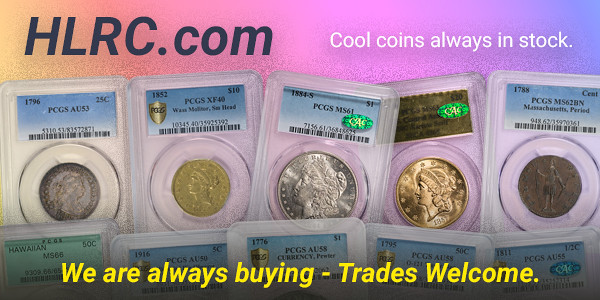
BILL FIVAZ TO SPEAK AT ANA NATIONAL MONEY SHOW
Bill Fivaz, coauthor of the Cherrypickers’ Guide to Rare Die Varieties of United States Coins, will give a “Money Talks” presentation at the February, 2019 ANA National Money Show. Here's a press release from Whitman Publications. -Editor
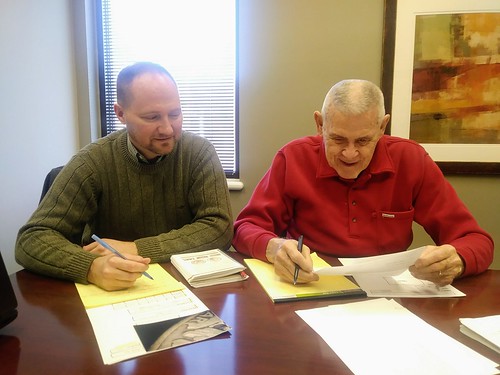
Dennis Tucker and Bill Fivaz reviewing
die varieties at a November 21, 2019, editorial meeting
Bill Fivaz, coauthor of the Cherrypickers’ Guide to Rare Die Varieties of United States Coins, will give an overview of today’s hobby and market at the American Numismatic Association’s National Money Show on February 27, 2020, in Atlanta.
“Cherrypicking” is the act of examining coins that appear normal at first glance to find ones that have unusual characteristics—overdates, doubled and tripled dies, misplaced mintmarks, and similar features—that reveal them to be scarce and valuable.
Fivaz, accompanied by Whitman publisher Dennis Tucker, will highlight some of the most popular new varieties that will be in the next Cherrypickers’ Guide. The focus of their talk will be Bust, Liberty Seated, and Barber silver coins, plus modern dimes, quarters, and half dollars from 1916 to date, silver dollars, clad dollars, gold coins, commemoratives, and coins struck for the Philippines under U.S. sovereignty.
The “Money Talks” presentation will be given at the Cobb Galleria Centre in Atlanta, Thursday, February 27, 2020, at 11:00 a.m.
Tucker called the presentation “A treat for everyone who dreams of finding a rare coin and cherrypicking it for a common-coin price.” Fivaz will answer these questions: “What are collectors today excited about? What has recent research revealed? What valuable treasures are waiting to be discovered?”
Bill Fivaz, a coin collector since 1950, has earned recognition as one of the country’s most respected authorities on numismatic errors and die varieties. He is a longtime contributor to the Guide Book of United States Coins (the “Red Book”). With the late J.T. Stanton he coauthored the first Cherrypickers’ Guide in 1990, launching the modern boom in interest in die varieties.
The Cherrypickers’ Guide uses close-up photographs and text descriptions to show collectors what to look for in die varieties. The sixth edition, volume II, is being edited by professional numismatist Larry Briggs. Its publication is scheduled for 2020, the thirtieth anniversary of the first edition’s release.

VOCABULARY TERM: CONDITION
Dick Johnson submitted this entry from his Encyclopedia of Coin and Medal Terminology. Thanks. We don't typically discuss condition or value, but this is a good overview tailored to the condition of medals. -Editor
Condition. State of preservation; or conversely, the degree of lack of wear. An elaborate – and sometimes indistinct – terminology has evolved for expressing this state of preservation, primarily for the purpose of collectors. Some coin series, for example, have as many as ten terms of condition or grade (ranging from poor to proof, although proof is not a condition) to express minute degrees of wear. This is not an exact science and human interpretation of condition often led to disputes between any two individuals particularly during transactions.
The popularity of coin collecting, and increasing demand for higher grade coins, has led to several attempts to make the determination of condition more precise A scale of about a dozen term names evolved in the early 19th century, followed by a numerical system expressing condition and applied to these terms. Photographic charts of popular series were published against which to compare specimens; these met with some success. Then computer grading was proposed, with dramatically less success. A new development in the field – of third party grading services (see below) – evolved with the greatest success of all.
Factors Affecting Condition
Abrasion and coin design. The primary factor of condition – abrasion – is the "wear" of circulating, as coins pass from one person to another, their storage, transportation and handling at every stage. It includes wear by normal handling, dropping, carried in pockets and purses, every type of rubbing and friction. It also includes every type of mishandling, the scratching, dropping sharp objects on coins, contact with any object that abrades or damages the coin's surface.
Uniform coin abrasion starts on the high point, and the more the item abrades from handling, the more relief is removed. A few microns of metal – the tiniest amount of weight – is dislodged and carried away. If abrasion continues to the extreme, as a very worn pocket piece, a slick, planchet-like disk would result (of several grains less weight than the original coin). But where the abrasion first occur, at high points, is of importance, as this has greatly influenced coin design.
Some coin designs have better "wearing" qualities than others, as coin designers have come to learn. The most useful technique is to raise the rim above all relief, in fact most coin designs are slightly basin shaped with the high point of relief actually lower than any point of the rim. In theory, therefore, the entire rim would have to wear away before the first wear appears on the design.
Coin condition factors to consider:
• Not all surfaces wear evenly, however, nor do both sides wear uniformly.
• In Europe, collectors and dealers grade each side of a coin separately (as: VF/F, meaning obverse very fine, reverse fine); in America one grade is determined for the piece as a whole.
• Toning or surface discolorations do not change a grade designation but is mandatory to be mentioned as a favorable or unfavorable aspect.
Factors affecting condition of medals. A medal's greatest enemy is its own weight. Heavy medals are extremely vulnerable to damage from dropping. Unless the medal has remained virtually undisturbed for its entire life, edge dents are common on large, heavy medals, these are termed EDGE KNOCKS or EDGE NICKS. Medals without these imperfections are said to have sharp edges.
Very light medals, on the other hand, as some European decorations, or HOLLOWBACK BADGES are pristine after years of use. These may have passed through a successions of owners and collectors and remained pristine, simply because they do not damage as greatly when dropped.
Often medals are issued in their own cases, this helps protect them. When a medal is sold years after its issue and still in its original case, this means that it has had some degree of protection during its lifetime. (It could have been extensively edge nicked or otherwise damaged from mishandling outside the case and returned to its case, but mostly a cased medal implies greater care has been exercised in its handling over the years.)
Another factor affecting medals is their ability to be REFINISHED. Other than perhaps plugging a hole, coins cannot be repaired or their finish changed. Medals, in contrast, can be repaired; upgraded in condition, and completely refinished – converted to pristine condition again. See repair and refinishing.
Medal condition factors to consider:
• Since medals do not circulate like coins they generally have high grade designations.
• Often a medallic item, as a badge or decoration, or medal in a mounting may have components of differing conditions, and should be noted separately
Looking for the meaning of a numismatic word, or the description of a term? Try the Newman Numismatic Portal's Numismatic Dictionary at: https://nnp.wustl.edu/library/dictionary
Or if you would like a printed copy of the complete Encyclopedia, it is available. There are 1,854 terms, on 678 pages, in The Encyclopedia of Coin and Medal Technology. Even running two a week would require more than 19 years to publish them all. If you would like an advance draft of this vital reference work it may be obtained from the author for your check of $50 sent postpaid. Dick Johnson, 139 Thompson Drive, Torrington, CT 06790.

HARRIET "HATTIE" P. ELLIS HAINES (1825-1903)
Harriet "Hattie" P. Ellis Haines (1825-1903), was born in November 1825 in New York, New York of parents who were natives of Connecticut, Daniel Corbin and Esther Copeland Corbin.
Harriet P. Haines, was an exceptional woman like many fine and noble women that love their children and develop their character caring for them lifelong. This particular unsung hero is the mother of famous stamp and coin dealer Frank Elmer Ellis of St. Louis Stamp & Coin. She founded St. Louis Stamp & Coin in order to help her insane son recover from his mental illness so that he could move on with his life and find happiness. A darling woman which American philatelic and numismatic history owes much gratitude for her resourcefulness as a model American woman and mother.
In 1849, she married John Ellis (1823-1881), at Adams, Jefferson County, New York, a huckster, i.e., door-to-door salesman. They had four children : Jerome H. Ellis (1849-), Marsha E. Ellis (1852-), Juliette E. O'Brien, nee Ellis (1855-), and her youngest child, future stamp and coin dealer Frank Elmer Ellis (1861-1937). The first two children were born in New York while the last two including Frank were born Pottstown, Chester County, Pennsylvania.
In 1870, they moved to Blairstown, Benton County, Iowa.
On November 2, 1882, 57 year old Harriet remarried to John Haines, a 65 year old farmer at Blairstown.
Her son Frank Elmer Ellis, seems to be the same as one Elmer Ellis who married Melinda M. Hemelright on October 2, 1884, at Philadelphia. In 1892, he worked as a telegraph operator in Plumerville, Arkansas, where he lost his mind. Plumerville was a stagecoach post established in 1858 in the Arkansas territory part of the old "Wild West". In 1873, it was a railway station for the Pacific Railroad carrying passengers, cargo and U. S. Mail service with a telegraph office at the station.
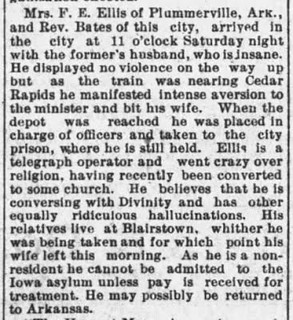 News report of how Harriet Haines sent Rev. Bailey of Cedar Rapids, Iowa to Plummerville [Plumerville] to fetch him. Charles Harrison Mason (1866-1961), an African-American charismatic preacher was a fanatic, and suicidal while preaching and licensed as a minister at Mount Gale Missionary Baptist Church in Preston, Arkansas in 1891, and in the area about the very small train station town of Plumerville when Frank Ellis worked there at the telegraph office. Ellis may have been influenced by him or his followers since they manifested similar psychological aberrations of talking to divinities and excited emotional and pathological behavior. Moreover, the town of Plumerville was in the throes of political intrigue, the assassination of newly elected Congressman John Clayton in 1889 at the rooming house of Mary Ann McCraven in Plumerville, and great tensions and scandal at the very time Ellis was returned to Cedar Rapids. The Gazette, Monday, September 12, 1892, page 5
News report of how Harriet Haines sent Rev. Bailey of Cedar Rapids, Iowa to Plummerville [Plumerville] to fetch him. Charles Harrison Mason (1866-1961), an African-American charismatic preacher was a fanatic, and suicidal while preaching and licensed as a minister at Mount Gale Missionary Baptist Church in Preston, Arkansas in 1891, and in the area about the very small train station town of Plumerville when Frank Ellis worked there at the telegraph office. Ellis may have been influenced by him or his followers since they manifested similar psychological aberrations of talking to divinities and excited emotional and pathological behavior. Moreover, the town of Plumerville was in the throes of political intrigue, the assassination of newly elected Congressman John Clayton in 1889 at the rooming house of Mary Ann McCraven in Plumerville, and great tensions and scandal at the very time Ellis was returned to Cedar Rapids. The Gazette, Monday, September 12, 1892, page 5
The 1895 Blairstown Census lists Harriet P. Haines living with 82 year old Joseph Haines on his farm.
 She moved to Cedar Rapids, Iowa sometime in 1896, with her son Frank.
She moved to Cedar Rapids, Iowa sometime in 1896, with her son Frank.
In February 1897, Harriet and her son Frank began a stamp dealership in Cedar Rapids, Iowa. Philatelic West, Vol. 3, No. 2, February (1897) : 10.
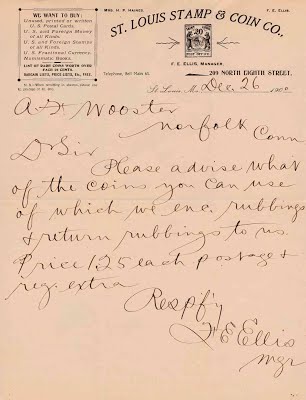 In the 1900 U. S. Census Frank Elmer Ellis was living in his mother's home at 1125 North 16th Street. Ellis made his mother a partner in St. Louis Stamp & Coin Company, taking on the role of manager.
In the 1900 U. S. Census Frank Elmer Ellis was living in his mother's home at 1125 North 16th Street. Ellis made his mother a partner in St. Louis Stamp & Coin Company, taking on the role of manager.
She died at her home 3125 Clifton Avenue, St. Louis, Missouri, on March 14, 1903.
On February 4, 1937, the 75-year old Frank E. Ellis was found shot to death in the bathtub with a self-inflicted gunshot wound to his chest from a 32 caliber revolver found laying at his side. Police estimated he had been dead ten days, but the Coroner’s report of John O’Connell estimated his death about February 1st.
To read the complete article, see:
HAINES, HARRIET P.
(https://sites.google.com/a/numismaticmall.com/www/numismaticmall-com/haines-harriet-p)
OTTILIA BUERGER'S ANCIENT COIN COLLECTION
Tom Casper submitted this article inspired by an earlier E-Sylum piece. Thank you! -Editor
By Tom Casper
We have all heard of grade schools as well as high schools utilizing coins to expand the subjects of art, history and geography. This is not only an excellent way to teach the connection between coins, rulers and countries but also to introduce to them the wonderful hobby of coin collecting.
Recently I became aware that a Wisconsin college is also teaching with coins. Lawrence University in Appleton, Wisconsin has a rare and massive collection of 420 ancient coins. It has been appraised as the third best ancient coin collection in the U.S. On October 15, 2019 the coins were shown in the Wriston Art Center Galleries, for Classics students taking Intensive Beginning Latin. The course is being taught by Assistant Professor of Classics, Adriana Brook, Assistant Professor of Art History. The theme for this year’s showing was animals on coins, and was given the clever name, The Ancient Coin Petting Zoo. Eight coins were passed around to students wearing gloves who were able to handle and study the coins. They have been doing this each year since 2014 with a different theme each year.
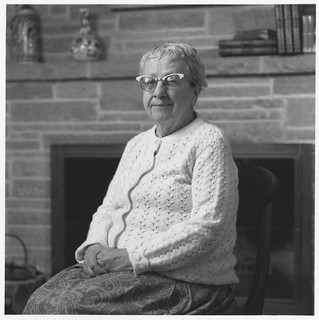 Roman, Greek and Byzantine coins are represented in the collection. The collection was donated to the
University by a Lawrence Alumna, Ottilia Buerger of Mayville, Wisconsin. She attended Lawrence from 1934 to
1938 receiving a Bachelor of Arts degree in Latin. She went on to teach English and Latin for the next several
years at schools in Goodman, Wautoma and Beaver Dam, Wis.
Roman, Greek and Byzantine coins are represented in the collection. The collection was donated to the
University by a Lawrence Alumna, Ottilia Buerger of Mayville, Wisconsin. She attended Lawrence from 1934 to
1938 receiving a Bachelor of Arts degree in Latin. She went on to teach English and Latin for the next several
years at schools in Goodman, Wautoma and Beaver Dam, Wis.
In 1958 she continued her interest in history by turning to numismatics, specifically ancient coins. Her first
purchase was at the coin shop in Gimbels Department Store in Milwaukee. It was a Roman denarius for about
$5. She thought she may buy some additional coins in the future but never thought of forming a collection. In
the mid-1960s she became serious in growing her collection. She continued buying coins from Gimbels, coin
dealer Edward Gans of Berkeley, CA, and Harlan Berk of Chicago. She than contacted dealers overseas,
Seaby’s and Spink & Sons of London. Nearly all the purchased coins were in mint condition. She loaned the
collection in Lawrence in 1995 and bequeathed to the University upon her death in 2001. By donating her
collection, she hoped enrich and enlighten student learning in art history, classical studies and history. A
portion of her collection, 232 coins, can be found on line at
http://thor.lawrence.edu/omeka/buerger/items/browse.
According to the curator, Beth Zinsli, the key piece is the collection is a large, gold medallion of Roman Emperor
Constantius II, 337-361AD. This piece is one of only three versions known. The obverse shows a bust of Emperor
Constantius facing right with the inscription DN CONST ANTIVS MAX A VGVSTVS. The reverse shows Constantius riding a
six-horse chariot with the inscription DN CONST ANTIVS VICTOR SEMPER A VG. The medal is not dated but has the mint
mark of Antioch (AN) in exergue. The medal weighs 40.04 grams with a diameter of 4.7cm. In 2005, a Lawrence
student, Julia Ruff wrote a 62-page Honors Project paper on this medallion. The website for this paper is
https://lux.lawrence.edu/luhp/70/.
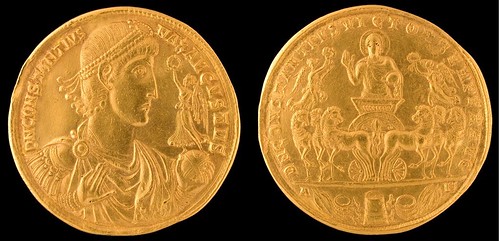
Constantius II Medal
Ottilia wanted her collection available to students so they can explore not only the historical and aesthetic importance of the coins themselves, but also their political, religious, economic and artistic contexts. This Ancient Coin Petting Zoo is certainly accomplishing her goal.
To read the earlier E-Sylum article, see:
THE ANCIENT COIN PETTING ZOO
(https://www.coinbooks.org/v22/esylum_v22n43a20.html)

CHIEF ENGRAVER JOSEPH MENNA
Lou Golino published a great article November 21, 2019 on Chief Engraver Joseph Menna, his impact on the U.S. Mint and where he may take the Mint in the future. Here's an excerpt; be sure to read the complete article online. -Editor
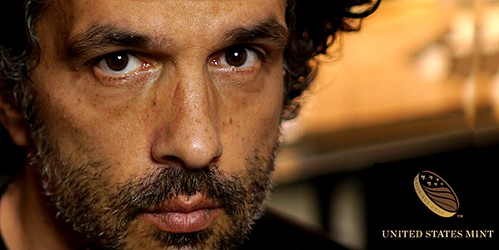
On February 4, 2019, U.S. Mint Director David J. Ryder appointed Joseph Menna – a New Jersey-raised artist and sculptor with almost 35 years’ professional experience — as the 13th Chief Engraver of the United States Mint. His appointment filled an important gap at the top of the Mint’s engraving and sculpting staff. The position had been vacant since 2010 when John Mercanti retired from the Mint after having held the position since 2006. Mercanti is best known as creator of the current reverse of the American Silver Eagle that the Mint plans to discontinue at the end of 2020.
Historically, artists and sculptors like Mercanti who have held this important position have created some of the best and most important coin designs in the history of the Mint. Other notable examples include the last presidentially-appointed Chief Engraver, Elizabeth Jones, who designed the 1982 George Washington half dollar, and George T. Morgan – the British-born engraver and sculptor best known as the creator of the Morgan silver dollar who later served as Chief Engraver.
Menna has for many years been one of the world’s leading digital sculptors and was an early adopter of 3D printing. His work creating pop culture collectibles is very extensive, and he said in a March 19, 2012 interview in Action Figure Insider that the biggest cultural influences on this work include “comic books, Star Wars and Dr. Who”.
But he also brings to his work extensive classical art training, including drawing and sculpture. After graduating from the University of Fine Arts with a Bachelor of Fine Arts and obtaining a master’s degree in the same field from the New York Academy of Art, he did post-graduate work in Russia at the Saint Petersburg Stieglitz Academy of Art and Design.
In Russia, Menna studied with Soviet-born artist Leonid Lehrman, who Menna described in a March 18, 2014, Philadelphia Inquirer article as “the guy who changed my life” and as his “Obi-Wan Kenobi”. He has also said that the artistic level of the art in Russia was superior to what was produced at the time in the West, where there was a lot of emphasis on abstract art.
Menna’s classical training and his use of digital technologies are complementary and reflected in both sides of his career. In his fandom-related work this enabled him to create works with incredibly detailed and lifelike details, while in coin development, whether a design is created with traditional plaster models or with computer software, all coin designs are later digitized so they can be refined.
To read the complete article, see:
The Coin Analyst: Chief Engraver Joseph Menna and the U.S. Mint’s Artistic Future
(https://coinweek.com/modern-coins/the-coin-analyst-chief-engraver-joseph-menna-and-the-u-s-mints-artistic-future/)

COX 1838-O HALF DOLLAR FINDS NEW HOME
In his November 20, 2019 blog article, E-Sylum supporter Doug Winter discusses his recent purchase of the Cox specimen of the 1838-O Half Dollar. -Editor
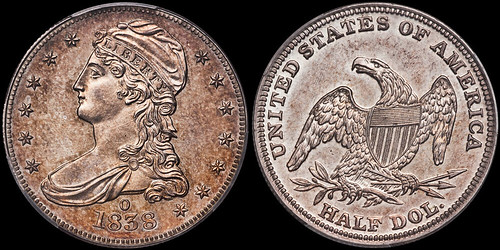
Douglas Winter Numismatics (DWN) a rare coin dealership based in Portland, OR was the buyer of a very rare 1838-O half dollar graded SP63 by PCGS and approved by CAC. Including a 20% buyer’s premium, the coin sold for $504,000 at the November 2019 Baltimore/Whitman Coin Expo conducted by Stack’s Bowers Auctions.
The New Orleans Mint opened in 1838 in order to provide silver and gold coins for the booming Southern economy. At this point in time, New Orleans was an economic powerhouse and there was a dire need for coins to facilitate day-to-day transactions and larger-scale purchases. Half dollars were an especially important denomination for the new mint, and striking the new design was a priority.
Only 20 half dollars dated 1838-O were produced and all were struck with special care. These coins were traditionally referred to as Branch Mint Proofs but are now called “Specimens” by PCGS. Very few Proofs of any year or denomination were made at this facility, and the 1838-O half dollars are the most famous silver issue from this mint (which continued to strike coins until it was closed in 1909). Of the 20 struck, it is believed that just nine are known today, with at least one off the market in a museum and many of the others held by leading private collectors.
This specific coin is graded SP63 by PCGS and it is known as the Cox-Robison coin, having been sold in the R.E. Cox auction conducted by Stack’s in 1962, and the Ellis Robison auction conducted by Stack’s in 1982. It was earlier owned by the famous collector “Col.” E.H.R. Green who owned no fewer than six of these at one time (!). It is interesting to note that this piece is fresh to the market, not having been offered for sale in over 35 years.
Winter purchased the coin for a New Orleans-based collector who specializes in Proof US coinage struck prior to 1840. According to Winter, “this is a coin we had been chasing for a long time. My client has always wanted an 1838-O half dollar and this is a culmination of the 30+ years we have worked together. We waited for the right coin and we feel we were able to purchase this beautiful example at a very favorable price.”
Since June 2005 there are 10 auction appearances for 1838-O half dollars, mostly in the PR63 to PR64 range. The two high water marks for the issue are $734,375 for an example graded SP64 by PCGS, and $763,750 for another coin graded SP64 by NGC; the two sales occurred in January 2014 and January 2013, respectively. The all-time record for an 1838-O half dollar graded SP63 was a coin which realized $632,500 in June 2005.
The 1838-O half dollar has long been recognized as a Classic Rarity in the pantheon of American Numismatics. According to Winter, “this is a coin which lacks controversy as it was made as a regular issue and not as a special concoction for collectors. It is from a popular, well-collected mint and it is a large-sized, aesthetically appealing issue. It is indisputably rare and it is very well-made since it was struck from carefully prepared planchets. To my way of thinking, it is curiously undervalued given what other far less desirable American coins sell for.”
To read the complete article, see:
DWN Buys Very Rare 1838-O Half Dollar
(https://raregoldcoins.com/blog/2019/11/20/dwn-buys-very-rare-1838-o-half-dollar)

1943 BRONZE LINCOLN DISCOVERY CENTS UNITED
Remember the Don Lutes discovery specimen of the 1943 bronze cent we discussed recently? It new owner has united it with another discovery coin - the Ken Wing 1943-S bronze cent. -Editor
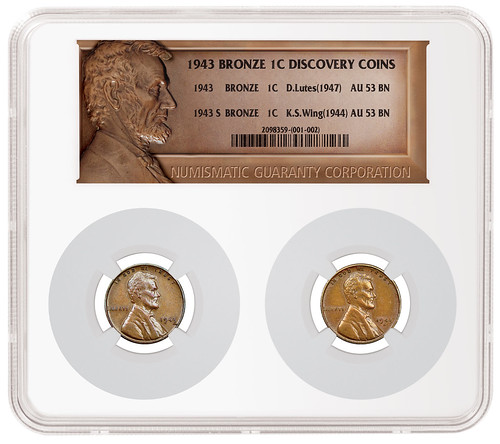
Brought Together Under One Owner
Two of the rarest and most famous US coins have been brought together under a single owner.
The 76-year-old coins look like regular Lincoln Cents from the era — bronze with the 16th president on one side, wheat ears on the other. Yet they were not supposed to exist. For years, US Mint officials claimed that they didn’t.
The teenaged boys who found them in the 1940s, one on the West Coast, one on the East, struggled to have them declared genuine and kept them their whole lives. The coins were sold after their deaths for more than $200,000 — each.
What makes such ordinary-looking coins so valuable? As in most things, it’s their rarity.
Some 1.1 billion Lincoln Cents were minted in 1943. But all of them were supposed to be struck in steel because the copper that normally made up 95% of the one cent coins was needed to make ammunition during World War II.
Yet rumors quickly began circulating that a very few 1943 Lincoln Cents had been made of bronze blanks left over from the previous year and that they were very valuable if you could find one. One rumor said Ford Motor Co. had offered a new car for one. That rumor proved to be untrue, though it was so widely spread that Ford and the US Mint were hard-put to answer the flood of mailed-in inquiries about it.
Ads ran in comic books and magazines as late as the 1950s offering $10,000 for one of the coins.
The Don Lutes Jr. 1943 Philadelphia Bronze Lincoln Cent and the Kenneth S. Wing Jr. 1943 San Francisco Bronze Lincoln Cent, each named for the teenaged boys who found them more than 70 years ago, were both certified as authentic by Numismatic Guaranty Corporation® (NGC®), a leading third-party authentication and grading service for collectible coins. NGC graded them both AU 53 separately. Now the two coins are displayed together in a single tamper-evident NGC holder.
To the man who brought them together, Concord, Massachusetts, coin dealer Tom Caldwell, the coins’ rarity, well-known stories and common-man appeal are what make them so attractive.
“These are coins that your neighbor knows about, not just hard-core collectors,” said the owner of Northeast Numismatics for 40 years.
“People love provenance, and the stories of these two coins are so well known.”
A 1943 Bronze Cent was first offered for sale in 1958, realizing more than $40,000, according to the US Mint. In 1996, a 1943 Bronze Cent was bought for $82,500. In 2010, a 1943-D Bronze Cent was sold for $1.7 million. That coin was especially rare — it is the only one known that was struck at the Denver Mint.
Only around 40 1943 copper–alloy cents are known to exist.
“The 1943 Bronze Cent is by far the most famous US Mint error,” says Mark Salzberg, NGC Chairman and Grading Finalizer. “Examples are extremely rare and highly coveted by collectors.”
Discovery coins
The Wing and Lutes coins both are what’s known among coin collectors as “discovery coins” — the first of their kind ever found and made known. One was minted in San Francisco, as indicated by an “S” mintmark. The other one does not have a mintmark, which indicates it was struck in Philadelphia.
But what of the discoverers? Wing was 14 in 1944 when he found one in Long Beach, California. His parents had been buying him rolls of one cent coins because he was collecting sets of them.
Lutes was 16 when he found his in change he received from buying lunch at his high school in Pittsfield, Massachusetts.
The young men spent years trying to get the US Mint to acknowledge that the coins were genuine. Wing finally succeeded in having his authenticated by Smithsonian Institution experts in 1957; Lutes’ was declared genuine by well-known numismatist Walter Breen in 1959.
Caldwell said he heard in the summer of 2018 that the coin that belonged to Lutes, who died in September 2018, was coming up for sale in January 2019. He purchased it for $204,000.
“We’d just sold a ’43 Bronze Cent of a slightly lower grade, so we had some idea of the market,” he said. “We were not expecting to buy it but were fortunate that we could get it at a reasonable price.”
Then the cent once owned by Wing, who died in 1996, was offered at auction in August 2019. “We bought it, again pretty reasonably, and put the two together in a single NGC holder,” Caldwell said. He paid $216,000 for the Wing coin.
The stories of how the coins were found were appealing. The sums for which they were sold this year caused them to receive coverage from the news media – even the non-numismatic ones — with headlines like “Coin found in lunch change fetches a pretty penny.”
The sales, particularly of the Lutes coin, were the subject of feature stories done by CNN, the New York Post, the Boston Globe, USA Today, and Newsweek and Fortune magazines, among other news outlets.
Now that the two coins are displayed in the same holder, Caldwell said he plans to display them at a few regional shows, then at the FUN show in Orlando in January and the Long Beach Expo show in California in February.
The pair will be sold eventually, Caldwell said. Now that they are together, he will not split them up.
For more information about Northeast Numismatics, go to northeastcoin.com/
For more information about Numismatic Guaranty Corporation, go to NGCcoin.com
What a powerhouse combination! Two great discovery coins with similarly great origin stories and provenance. Congratulations to Tom for uniting the pair and thanks to NGC for developing the classy custom slab. Be sure to visit the Northeast Numismatics table at future shows to see the pairs in person. They'll be at the Mt. Kisco show in Connecticut December 15th and the upcoming F.U.N. and Long Beach shows. -Editor
To read the earlier E-Sylum article, see:
MEDIA COVERAGE OF LUTES 1943 COPPER CENT
(https://www.coinbooks.org/v22/esylum_v22n02a28.html)
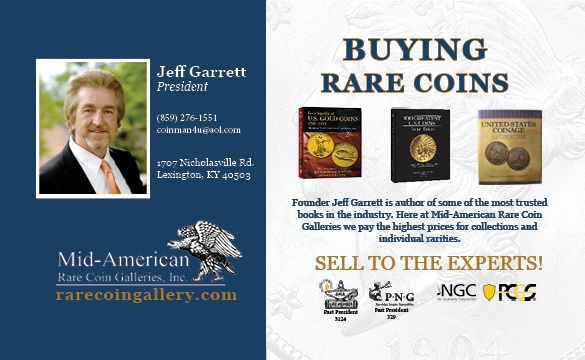
SEDWICK NOVEMBER 2019 SALE RESULTS
Here's a press release with results from the recent Sedwick sale, with images of some lots we hadn't published before. -Editor
Several important coin collections crossed the auction block during Daniel Frank Sedwick LLC’s Treasure Auction 26. The live floor and online auction, held Nov. 1-2, realized over $2.3 million in coins, medals, and bank notes sold.
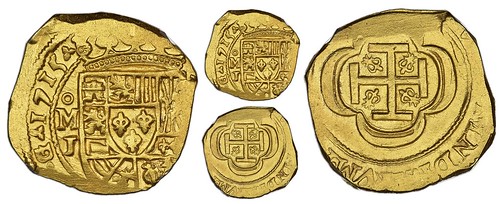
1715J cob 4 escudos
The auction began with the John Pullin Collection of dated Mexican gold cob escudos. All of the coins were recovered from various wrecks of the 1715 Fleet, sunk on July 31, 1715 off Florida’s east coast. In just 18 lots, a total of $150,476 was raised. The highest price realized was for lot 7, a cob 4 escudos dated 1715J and graded by NGC as MS 62 that sold for $28,560 on an estimate of $10,000 to $20,000. This result was followed closely by lot 3, a cob 8 escudos dated 1714J and graded NGC MS 60 that saw $21,420 on an estimate of $20,000 and up. This coin boasts a pedigree to the salvors’ Real Eight Company collection as well as being plated in a January 1965 National Geographic article on the 1715 Fleet’s history.
An additional $46,809 was garnered by the sale of 66 silver cob reales from Pullin’s collection. Most of the coins were dated, a quality scarcely seen on Mexican cobs for the time period. Many of these coins also hold pedigrees to the 1715 Fleet. The top selling silver lot was lot 322, a Mexico City, Mexico, cob 8 reales dated 1709J that realized $3,332 on an estimate of $350 to $500.
All told, the John Pullin Collection earned $197,285 during Sedwick’s sale. The collector, John Pullin, gave a talk at the auction the day prior to the sale on collecting 1715 Fleet coins and how his collection was assembled. He also personally signed the lot tags for his coins in the sale.

Gold "finger" bar
A similar shipwreck coin collection, the Atocha Classics Collection, attracted interest from numismatists and shipwreck enthusiasts alike. The curated group was comprised of 49 lots of high-quality silver cob reales of various denominations recovered from the wreck of the Atocha, sunk in 1622 off Key West, Florida. The collection realized $112,812 after spirited bidding.
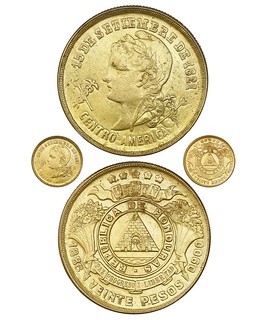 The top selling lot was lot 149, a Potosi, Bolivia, cob 4 reales from the reign of Philip II that
brought in $7,735 on a $2,000 to $3,000 estimate. The coin was awarded Grade 1, the highest
possible grade for Atocha coins, on its special Mel Fisher, Inc. photo-certificate. It was also
pedigreed to the Atocha Research Collection and plated in that collection’s 1988 catalog.
The top selling lot was lot 149, a Potosi, Bolivia, cob 4 reales from the reign of Philip II that
brought in $7,735 on a $2,000 to $3,000 estimate. The coin was awarded Grade 1, the highest
possible grade for Atocha coins, on its special Mel Fisher, Inc. photo-certificate. It was also
pedigreed to the Atocha Research Collection and plated in that collection’s 1988 catalog.
The third session of the auction contained the Whittier Collection of Bolivian Monetary Medals that raised $67,110 across 109 lots. The highest selling lot was lot 622, a Potosi, Bolivia, 10 soles dated 1825 commemorating Simon Bolivar’s liberation of Chuquisaca and graded by PCGS as MS64 that sold for $2,975.
A second offering of Whittier Bolivian medals will appear in Sedwick’s April 2020 Treasure Auction.
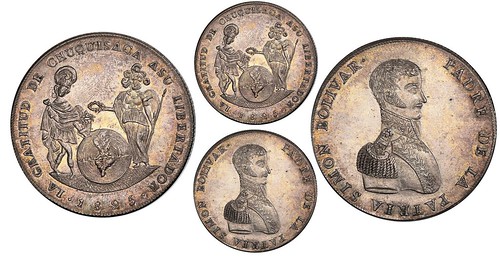
Lot 622: Potosi, Bolivia, 10 soles 1825
The sale also hosted the Santander Collection of Colombian Proclamation Medals. The collection, an assemblage of the rarest Colombian medals issued from 1724 to 1825, reached $34,391 across 17 lots. The highest selling lot was lot 1137, a Bogota, Colombia, silver uniface 4 reales-sized die trial dated 1789 that realized $12,495 on a $7,000 to $10,000 estimate.
Aside from numismatic collections in the auction, other top earners include lot 82, a gold “finger” bar weighing 1.325 kilograms recovered from the Atocha that realized $77,350 on a $50,000 and up estimate. An 88 troy pound, 7.04 troy ounce silver bar from the same wreck, lot 92, fetched $44,625 on a $25,000 and up estimate.
The highest valued coin in the auction was lot 942, a Honduras gold 20 pesos dated 1888 and graded NGC AU 58. With an estimated mintage of 30 or fewer pieces and only three survivors known today, heavy bidding was expected. When the hammer dropped, the final sale price was $71,400 on a $40,000 and up estimate.
Other top lots in the auction include:
- Lot 85 – Small gold disk weighing 373 grams from the Luz shipwreck (1752), sold for $30,940 on an estimate of $17,500 and up.
- Lot 42 - Lima, Peru, cob 4 escudos, 1705H, NGC MS 62, finest and only example in NGC census, ex-1715 Fleet, sold for $28,560 on an estimate of $10,000 and up.
- Lot 407 - Mexico City, Mexico, cob 8 reales Royal (galano), 1715J, NGC XF details / plugged, repaired, sold for $20,230 on an estimate of $15,000 to $22,500.
- Lot 544 - Panama, cob 1 real, Philip II, assayer oX below denomination I to right, mintmark AP to left, king's name missing in legend, unique, sold for $20,230 on an estimate of $3,500 and up.
- Lot 437 - Lima, Peru, cob 8 reales, 1659V (Series II), Royal-die obverse (unique), with Guatemala sun-over-mountains countermark (Type II, 1839) on cross, plate coin in the Standard Catalog, sold for $11,305 on an estimate of $6,000 to $9,000.
- Lot 534 - Potosi, Bolivia, cob 2 reales Heart, 1685VR, unique, sold for $10,710 on an estimate of $5,000 and up.
- Lot 1082 - Arequipa, Peru, 1/5 sol, 1885AC, NGC AU 55, finest known, ex-Whittier (stated on label), plated in the Standard Catalog, sold for $10,115 on an estimate of $5,000 and up.
- Lot 298 - USA (San Francisco Mint), gold $20 coronet Liberty "double eagle," 1863-S, PCGS AU58 / Brother Jonathan (1865), sold for $8,330 on an estimate of $8,000 to $12,000.
Full prices realized can be viewed at auction.sedwickcoins.com. The company’s next auction will be held April 30, 2020 with a consignment deadline of March 1, 2020. Consignments can be done in person at the FUN Show (Jan. 9-12), New York International (Jan. 17-19), and Long Beach Coin Show (Feb. 20-22) or by email at office@sedwickcoins.com.
To read the earlier E-Sylum article, see:
SEDWICK NOVEMBER 2019 SALE HIGHLIGHTS
(https://www.coinbooks.org/v22/esylum_v22n40a20.html)
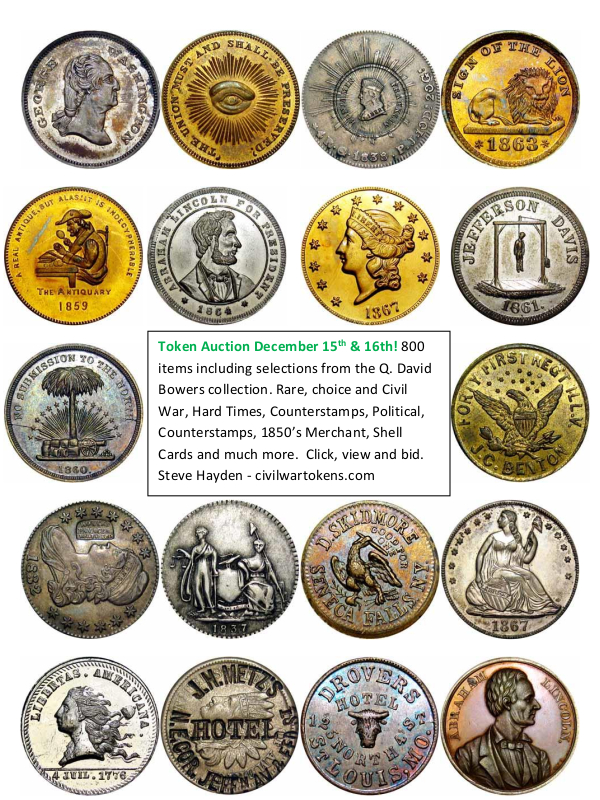
NUMISMATIC NUGGETS: NOVEMBER 24, 2019
Here's a selection of interesting or unusual items I came across in the marketplace this week. Tell us what you think of some of these. -Editor
The 1784 Catch Club Gold Medal
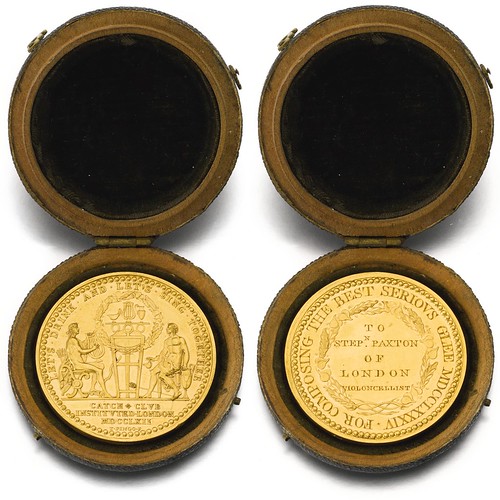
THE CATCH CLUB 1784 GOLD MEDAL
inscribed FOR COMPOSING THE BEST SERIOUS GLEE MDCCLXXIV / STEPN PAXTON OF LONDON / 'Violoncellist'; the reverse with Orpheus and Bacchus inscribed LETS DRINK AND LETS SING TOGETHER, Catch Club, instituted London 1762, the medal signed T. PINGO F., in original fishskin case
44mm. diameter and 73.6g, 2.596oz
Catalogue Note
The Catch Club was originally founded in 1761 (and instituted a year later) to encourage the composition and performance of glees, catches and canons. Viscount Gladstone in his 1930 essay, The Story of the Noblemen and Gentleman's Catch Club, writes that from May 1762 it was decided to institute a gold medal worth 10 guineas 'for the best catch, canon and glee, words and music'. He also refers to the present medal being 'in the possession of Miss Willmott'.
Stephen Paxton won three of the club's medals for 'How Sweet, How Fresh' (1779), 'Round the Hapless Andrés Urn' (1781) and 'Blest Power Here See' (1784) for which the present medal was awarded.
From Sotheby's. -Editor
To read the complete lot description, see:
THE CATCH CLUB 1784 GOLD MEDAL
(https://www.sothebys.com/en/buy/auction/2019/spetchley-property-from-the-berkeley-collection/the-catch-club-1784-gold-medal)
1848 $2 1/2 CAL. Gold Liberty
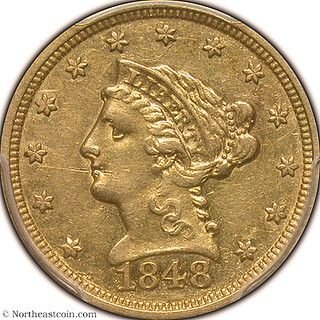
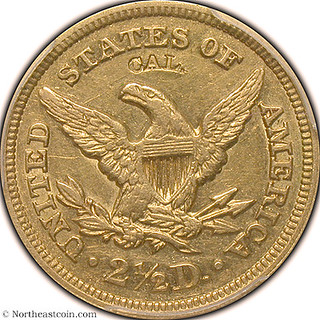
This is the first problem-free example of this rarity that we've had the pleasure of offering. From PCGS CoinFacts: On January 24, 1848, James Wilson Marshall noticed some small flakes of yellow metal near the Sutter's Mill project outside Coloma, California. Marshall's discovery turned out to be gold, touching off one of the largest voluntary migration of humans the world has ever known -- the California Gold Rush. In December 1848, the Military Governor of California, Col. R.B. Mason, sent 228 ounces of newly mined gold to the Secretary of War, William L. Marcy. Marcy forwarded the gold to the Philadelphia Mint, with instructions to use the gold for Congressional Medals for Generals Zachary Taylor and Winfield Scott. Any leftover gold was to be turned into specially marked Quarter Eagles. 1,389 1848-dated Quarter Eagles were struck from the California gold shipment, each one stamped with a small "CAL." in the upper reverse field. The stamping appears to have been done while the coins were still in the press, as none of the obverse features appear to have been flattened.
While testing this week's ads I clicked on Northeast Numismatics and found a number of great featured items in their inventory. Here's one important rarity I've never had the pleasure of owning. -Editor
To read the complete item description, see:
1848 $2 1/2 CAL. Gold Liberty PCGS AU53 $62,500
(https://www.northeastcoin.com/featuredCoinDetail.jsp?FtrdCoinId=589)
1861 50c Confederate States of America Restrike
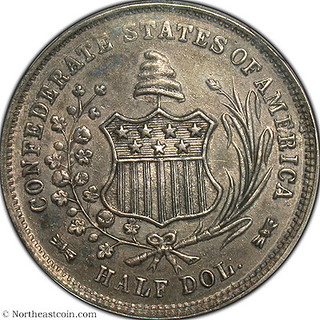
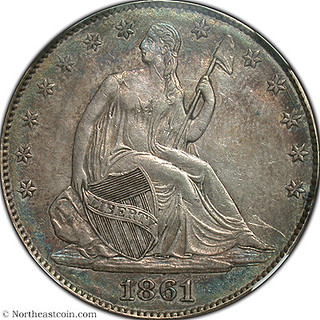
From NGC's website: Only four original Confederate Half Dollars were struck in 1861. The Confederate reverse die, however, was kept by Chief Coiner Dr. B. F. Taylor, and in 1879 he sold the die along with his original 1861 Confederate Half Dollar to coin dealer Ebenezer Locke Mason, Jr, who in turn sold the die and coin to J. W. Scott. Scott polished the Confederate reverse die to remove some of the rust that had accumulated and paired it with a new die that gave a brief explanation of the history.
500 of these tokens were struck by Scott in white metal and sold to collectors. After these tokens were minted, Scott overstruck a limited number of 1861 Seated Liberty Dollars with the Confederate reverse in an attempt to mimic the original 1861 Confederate Half Dollar design. There are two types of these restrikes: B-8001, which has the Seated Liberty reverse design prominently visible beneath the Confederate design, and B-8002, which was struck after the Seated Liberty reverse was completely effaced and no longer visible. NGC Price Guide is $13,900.
Here's another great item from Northeast Numismatics. I did own a nice example in my U.S. Civil War collection. -Editor
To read the complete item description, see:
1861 50c Confederate States of America Restrike B-8002 NGC MS61 $11,750
(https://www.northeastcoin.com/featuredCoinDetail.jsp?FtrdCoinId=585)
1943 Steel Cent Planchet Strip
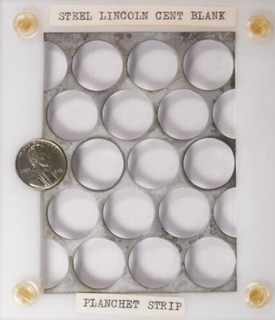
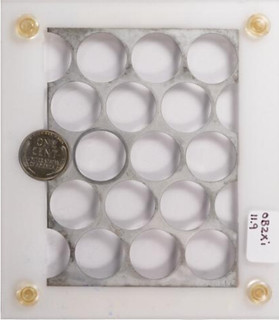
1943 steel cent planchet strip, used a the Mint for creating 1943 steel cents. The piece measures 3 3/4 inches X 2 3/4 inches. It is housed in a customer Capital Plastic holder, which makes for a very nice presentation! A 1943 steel cent is included within the set as a comparison example.
Wow! What a great piece of numismatic history! From Jon Sullivan's web site. -Editor
To read the complete item description, see:
1c (1943) steel cent web strip
(https://www.sullivannumismatics.com/coin/1c-1943-steel-cent-web-strip?v=5593)
THE BOOK BAZARRE
WAYNE'S NUMISMATIC DIARY NOVEMBER 24, 2019
On Tuesday November 19, 2019 I left my office and arrived at J. Gilbert's steakhouse in McLean, VA around 6pm. Roger Burdette was the host for our Northern Virginia numismatic social group Nummis Nova. Dave Schenkman had been the first to arrive and I took a seat next to him in the lobby. Eric Schena arrived soon afterward and before long a small group of us was led back to a private room. Others attending included Roger, Steve Bishop, Wayne Herndon, Mike Packard, Jon Radel, and Chris Neuzil. Jonas Denenberg was my guest.
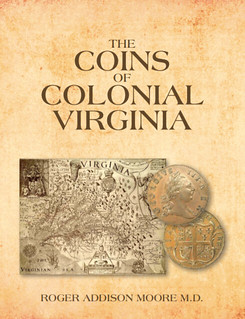
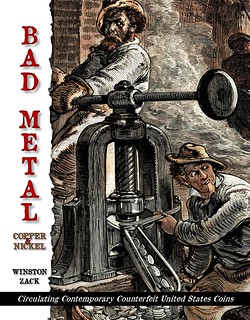
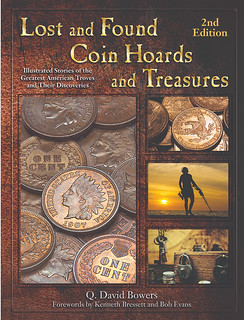 I brought along three recent acquisitions for my numismatic library:
I brought along three recent acquisitions for my numismatic library:
The Coins of Colonial Virginia by Roger A. Moore
Bad Metal: Copper and Nickel Circulating Contemporary Counterfeit United States Coins by Winston Zack
Lost and Found Coin Hoards and Treasures 2nd edition, by Dave Bowers
Book business had been brisk at the recent Baltimore show. David Kahn sold 60 or 70 copies of Winston's book at the show, and I think Charlie Davis sold out of all the copies of Roger's book he brought to the show.
Dave's Unlisted Explosive Control Tokens
Ever since a flea market find as a kid, I've enjoyed the "Good for One Exploder" and "Good for One Stick Dynamite" type tokens from the U.S. mining industry. Dave Schenkman brought two unlisted explosive control tokens and kindly provided these images.
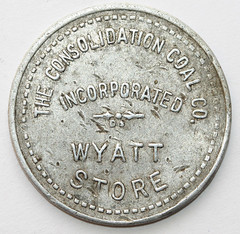
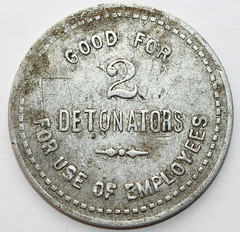
Consolidation Coal Company Two Detonators
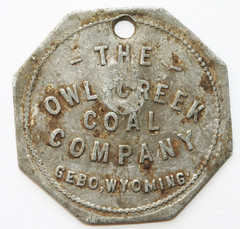
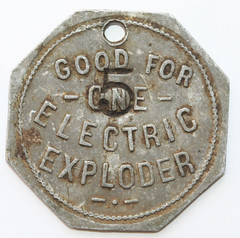
Owl Creek Coal Company One Electric Exploder
Steve's Beauties
Steve Bishop's collecting taste spans a wide range. He provided these photos and descriptions of his recent acquisitions. Thanks!

1757 1 K Overstruck Swedish 1 Ore
The 1757 1 kopeck is one of the few Russian coins that can be found struck over a coin of another country.
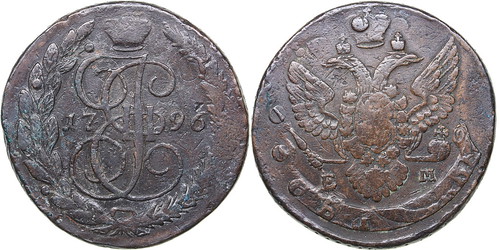
1796 EM 5K Reoverstriking 3
The 1796 5 kopeck reoverstriking is usually found dated 1793.
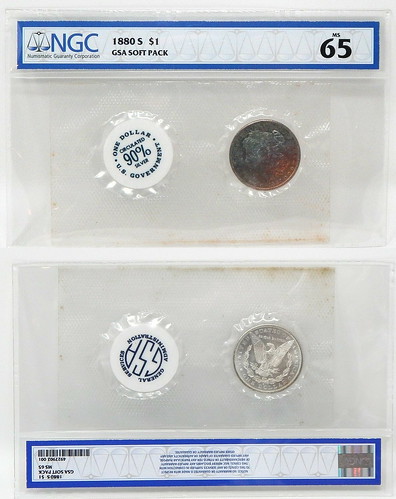
1880-S Morgan NGC MS65 GSA Flat Pack Toned
Virtually all of the GSA hoard dollars were Carson City. Other mints were packaged in the soft flat pack
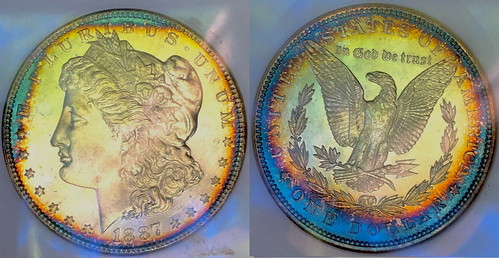
1887 Morgan NGC MS64 Toned
The 1887 Morgan just has amazing blue toning on the reverse
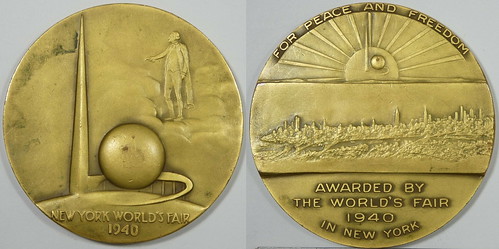
1940 World's Fair Award Medal Prototype
The 1940 World's Fair medal is unusual in that the vast majority of medals awarded were dated 1939 and had a slightly different design. Very few of the 1940 version were made.
It can be hard to see details and color in restaurant lighting. Photos can really bring out the best in a coin or medal.
Gettysburg Address
We hadn't realized it when planning this meeting, but it was held on the anniversary of Abraham Lincoln's Gettysburg Address. I mentioned this, and Steve began reciting it from memory. In honor of this short but powerful speech, I'll reprint it here.
Four score and seven years ago our fathers brought forth on this continent, a new nation, conceived in Liberty, and dedicated to the proposition that all men are created equal.
Now we are engaged in a great civil war, testing whether that nation, or any nation so conceived and so dedicated, can long endure. We are met on a great battle-field of that war. We have come to dedicate a portion of that field, as a final resting place for those who here gave their lives that that nation might live. It is altogether fitting and proper that we should do this.
But, in a larger sense, we can not dedicate — we can not consecrate — we can not hallow — this ground. The brave men, living and dead, who struggled here, have consecrated it, far above our poor power to add or detract.
The world will little note, nor long remember what we say here, but it can never forget what they did here. It is for us the living, rather, to be dedicated here to the unfinished work which they who fought here have thus far so nobly advanced. It is rather for us to be here dedicated to the great task remaining before us — that from these honored dead we take increased devotion to that cause for which they gave the last full measure of devotion — that we here highly resolve that these dead shall not have died in vain- that this nation, under God, shall have a new birth of freedom — and that government of the people, by the people, for the people, shall not perish from the earth.
The meeting had largely broken up by 9:30. I sat talking for a while with Wayne Herndon and learned some of his numismatic origin story. He was a collector as a kid and one day their postman delivered someone else's copy of Coin World by mistake. He returned it, but kept one of the postcards he found inside and bought his own subscription..
It was another great evening of numismatic fellowship. It's always fun to see fellow collectors, look at some interesting numismatic items, and shoot the breeze about everything within and beyond the world of numismatics. 'Til next time.

COINAGE OF THE GUPTAS
Mike Markowitz is my favorite columnist on ancient coins. It's been a while since I've mentioned one of his articles. On November 19, 2019 he published a piece for CoinWeek on coinage of the Gupta Empire. Here's an excerpt; see the complete article online. -Editor
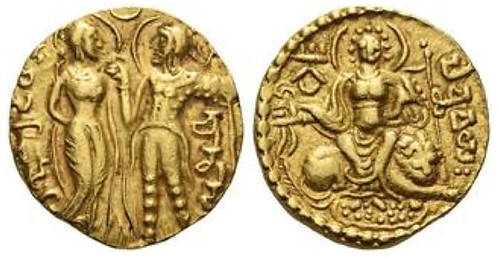
Chandragupta I. Dinar, King and Queen type, circa 319-343, AV 7.61 g.
Chandragupta I was the first Gupta king to issue gold coins. Designs were influenced by the coins of the earlier Kushan Empire. In older catalogs (Allan, 1914; Altekar, 1954), many of his coins were attributed to his grandson, Chandragupta II. He made a brilliant political marriage with Kumaradevi, princess of the Licchavi, a powerful neighboring state. They stand together facing one another on the obverse of the “King and Queen” type dinara. Lakshmi, goddess of prosperity, appears on the reverse, seated on a lion. The dinara of about 7.8 grams, struck in nearly pure (94%) gold, was based on the weight of the Roman aureus, a coin that reached India in large quantities to pay for spices and silks.
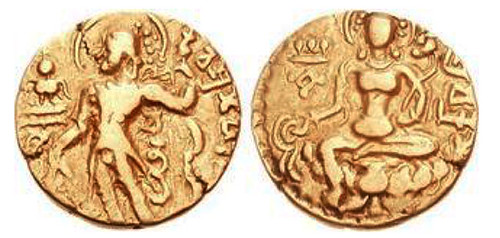
Chandragupta I. Circa AD 320-335. AV Dinar (7.74 g, 12h). Archer type.
Chandragupta I issued other designs that were copied by subsequent rulers, including the “Archer type” which shows the king standing, holding a curved composite bow in one hand and an arrow in the other. Beside the king is the dynastic emblem, the “Garuda standard”: a staff topped with an image of Garuda, a mythical bird and companion of the god Vishnu. Kumar (2017) suggests this derives from the Roman eagle legionary standard, which would have been familiar to Indians from depictions on Roman coins.
Mike does his homework and he's a great explainer - he can break down complicated topics so it all makes sense somehow. -Editor
Mike writes:
Work in progress for publication online in the next few months includes articles on the Celtic coinage of ancient Gaul, and on the late Roman and Byzantine coinage of the Ravenna mint.
At the NYINC in January, I will be giving a talk on the coinage of medieval Cilician Armenia, and a presentation on "Why Byzantine Coins Became Cup-Shaped."
To read the complete article, see:
CoinWeek Ancient Coin Series: Coinage of the Guptas
(https://coinweek.com/ancient-coins/coinweek-ancient-coin-series-coinage-of-the-guptas/)

DETECTORISTS CAUGHT TAKING ANGLO-SAXON HOARD
Dick Hanscom, Pablo Hoffman, David Pickup and Arthur Shippee forwarded articles about amateur metal detectorists who uncovered a great hoard of Anglo-Saxon coins and jewellery, but didn't report it to authorities as required by law. The four men could face jail terms and the hoard may eventually be exhibited at the British Museum and in a museum in Herefordshire. -Editor
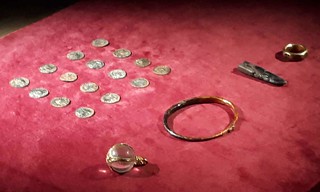 Powell and Davies unearthed a hoard hidden more than 1,000 years ago, almost certainly by a Viking warrior who was part of an army that retreated into the Anglo-Saxon kingdom of Mercia after being defeated by Alfred the Great in 878.
Powell and Davies unearthed a hoard hidden more than 1,000 years ago, almost certainly by a Viking warrior who was part of an army that retreated into the Anglo-Saxon kingdom of Mercia after being defeated by Alfred the Great in 878.
There was gold jewellery including a chunky ring, an arm bracelet in the shape of a serpent and a small crystal ball held by thin strips of gold that would have been worn as a pendant. Beneath the gold were silver ingots and an estimated 300 silver coins.
The law is clear: such finds should be reported to the local coroner within 14 days and failure to do so risks an unlimited fine and up to three months in prison. Any reward may be split between the finder, land owner and land occupier.
Powell and Davies, experienced detectorists from south Wales, chose a different route. Two days later they went to a Cardiff antiques centre called the Pumping Station and showed some examples of their find to coin dealer Paul Wells. He immediately knew they were very special.
The crystal ball pendant turned out to be the oldest item, probably dating from the 5th or 6th century, while the ring and arm bracelet are thought to be 9th- century. They were described as priceless in court. Nothing like the arm bracelet has ever been seen by modern man before.
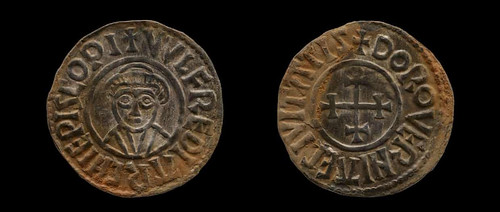
But if anything, the coins turned out to be even more significant. Among them were extremely rare “two emperor” coins depicting two Anglo-Saxon rulers: King Alfred of Wessex and Ceolwulf II of Mercia. They are important because they give a fresh glimpse of how Mercia and Wessex were ruled in the 9th century at about the time England was morphing into a single united kingdom.
Still, the pair did not contact the authorities. Instead Powell got in touch with another treasure hunter, Simon Wicks from East Sussex, and two weeks after the find he presented himself at upmarket coin auctioneers Dix Noonan Webb in Mayfair, central London.
Wicks put a selection of the coins found in Herefordshire, including a pair of the two emperors, in front of one its leading experts. The expert gasped when he saw the coins and suggested the two emperors could be worth £100,000 each.
To read the complete articles, see:
Detectorists hid find that rewrites Anglo-Saxon history
(https://www.theguardian.com/uk-news/2019/nov/21/detectorists-hid-find-that-rewrites-anglo-saxon-history)
To read other articles, see:
Detectorists stole Viking hoard that 'rewrites history'
(https://www.bbc.com/news/uk-england-hereford-worcester-50461860)
VIDEO: The stolen Viking treasure that could 'rewrite history'
(https://www.bbc.com/reel/video/p07vkc26/the-stolen-viking-treasure-that-could-rewrite-history-)
Metal detectorists who stole £3m Viking hoard told they have 'cheated the public' as they are jailed
(https://www.telegraph.co.uk/news/2019/11/22/metal-detectorists-stole-3m-viking-hoard-told-have-cheated-public/)

VICTORIA GOLDEN JUBILEE GOLD MEDAL
Jeremy Bostwick's November 21, 2019 Stack's Bowers blog article describes an interesting Victoria Golden Jubilee medal in the firm's upcoming NYINC sale. -Editor
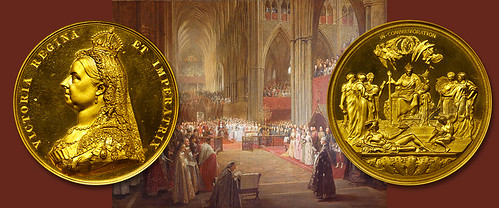
Upon the death of William IV—the third male child, and third overall, of George III—the crown passed to Victoria, his niece and the reigning Princess of Kent. Since the crowning of George I over 100 years earlier, the British crown and the German Hanoverian crown were in personal union. George I had been the hereditary elector of Hanover at the time he succeeded Queen Anne, this on account of his having descended from Sophia, the protestant electress consort of Hanover. As the electorate of Hanover followed Salic Law, with a strict adherence to agnatic succession, the crown could only pass to males, excluding Victoria in favor of her uncle, Ernest Augustus. With the personal union ended, the newly-crowned Victoria—just 18 years old at the time of her accession in 1837—would begin a extensive reign that would see an entire era named in her honor.
Though lengthy reigns aren't as uncommon now, lifespans even just 150 years ago were not what we currently enjoy, and a monarch's 50 year reign, generally known as a 'golden jubilee,' was an event to be widely and monumentally celebrated. As such, Victoria's ceremonies in 1887 extended to all parts of the United Kingdom—not just locally in London, but throughout England and the British Isles, and around the vast British Empire, stretching from Canada to Australia, with portions of Africa and the Indian subcontinent in between. Numismatics was also tapped as a source of commemoration, with Victoria's coinage undergoing the well-known 'jubilee' redesign. In addition, countless medals, both official and unofficial, were produced by a faithful realm.
Featured in our forthcoming Official Auction of the 2020 N.Y.I.N.C. will be one such astonishing piece of medallic art: a large gold medal of the highest quality and craftsmanship. Certified by NGC as PROOF-64+ Ultra Cameo, this specimen, the finest in gold which one could acquire, offers breathtaking perfection and wondrous artistry. The surfaces are extensively mirrored and free from the usual hairlines which plague similar issues, while the devices present an unrivaled intricate nature. One need not look any further than Victoria's veil—the delicate lace of which has been exceptionally executed—to discover the impressive engraving skill utilized in the creation of this rare Gem. With a mintage in gold of just 944 pieces, it is easy to see why this specimen's state of preservation is extraordinary, and why it is assuredly worthy of the attention of advanced collectors of Victorian material..
To read the complete article, see:
An Extraordinary Gold Medal for Victoria's Extraordinary Golden Jubilee
(https://www.stacksbowers.com/News/Pages/Blogs.aspx?ArticleID=jubilee-medal-2020-nyinc)
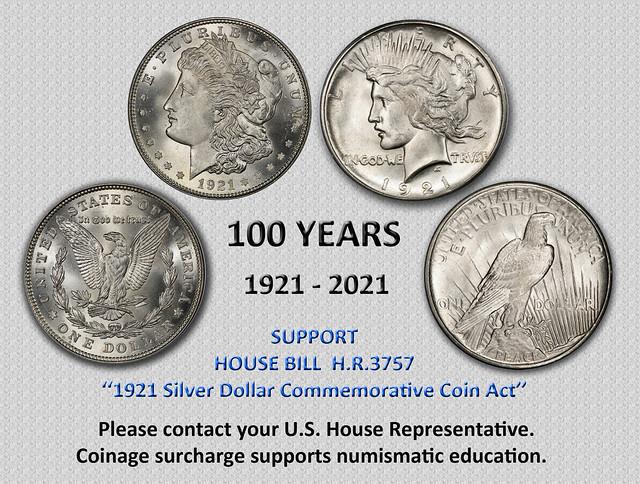
SMITHSONIAN EXHIBITS MCGRAW MEDAL OF HONOR
Frank Blazich Jr. is a curator in the Smithsonian's Division of Political and Military History. On November 15, 2019 he published an article on the museum's O Say Can You See? blog about a new Medal of Honor display. Here's an excerpt. -Editor
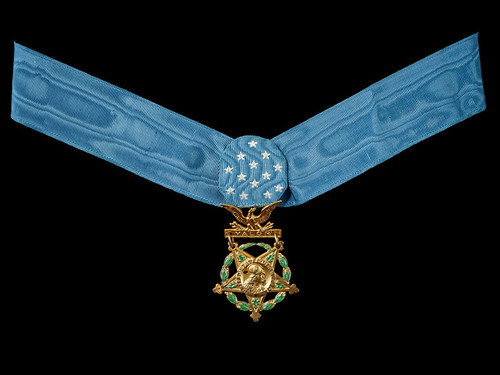
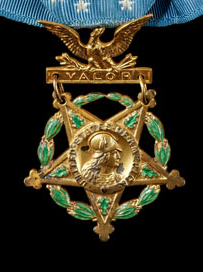
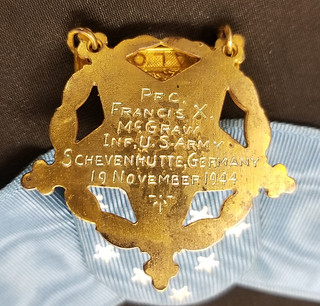
McGraw remained at his gun, firing on advancing German infantry. Their assault faltering, the Germans took cover, brought up a machine gun, and aimed at McGraw. Seeking a better vantage point, McGraw stood up in his foxhole, exposing himself to enemy fire, positioned his machine gun, and proceeded to silence the enemy gun.
The Germans next brought up antitank rockets called Panzerfausts. A blast hit near McGraw, knocking his machine gun aside. Retrieving the weapon, McGraw acquired his targets and returned fire. A second machine gun targeted him, and McGraw stood up again, silencing the enemy weapon.
Ammunition began to run low.
“The fire was so intense that the ammunition bearers were unable to cover the short distance to the ammunition dump where supplies were stored in a deep trench,” First Sergeant Joseph Baruno remembered. “I saw Private McGraw make three trips to pile up supplies next to his gun. He was hit on the last trip.”
There's more to the story - see the complete article online. And if you're in town this month, see the medal at the Smithsonian's Price of Freedom exhibition. -Editor
To read the complete article, see:
The quiet hero from Camden: Francis X. McGraw
(https://americanhistory.si.edu/blog/mcgraw/)

CHINESE RUN FROM FALUN GONG OVERSTAMPED NOTE
This article from Vice describes a journalist's trouble spending a Chinese banknote that frightens nearly every person it's presented to. -Editor
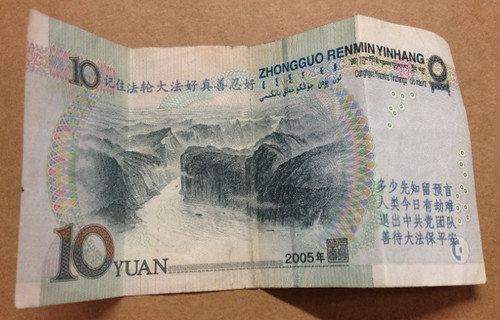
I have a very special Chinese banknote. It’s only worth ten Yuan, but it might be the most precious object I own. The front of the note shows a drawing of the former leader of the Communist Party, Mao Zedong. Rumour has it, he spent every night with the young, virginal daughters of different farmers, because he believed popping cherries was the key to eternal youth. But that little factoid is not what makes this banknote so special. What’s special about my banknote is that in China – a country where everything is about money, money and more money – nobody accepts the damn thing. It’s practically worthless. And I now understand why.
At first sight, it was just an ordinary 10 Yuan. Mao, a small rose and the official logo of the Communist Party were on the front, while a charming Chinese mountain scene with rivers was on the back. But if you look closer, you’ll see the stamps. Amy pointed them out to me a few days after the incident. There were Chinese characters on the bill that didn’t belong there. “This is anti-Communist Party,” she said. “The note says you have to abandon the Party in order to be free.”
In China, protesting against the Chinese Communist Party (CCP) is dangerous – especially if you disrupt the public peace. And in China this is a pretty broad concept. Just take Weibo, the Chinese version of Twitter, for instance. If you are retweeted more than 500 times on Weibo with a message that the CCP deems inappropriate, you’ll end up spending years in prison. Every form of protest is suppressed and severely punished. And still, there I was with this banknote of ten Yuan in my hand telling me to leave the Party. How was this possible? In China, it was impossible to answer the question. Nobody wanted to discuss the bill with me. But the more people turned me down to talk about it, the more I wanted to solve the mystery of my strange banknote.
After my trip in China, I travelled to the Netherlands. Although, I was finally beyond the reach of the CCP, I didn’t even know where to start in terms getting to the bottom of the banknote. So, I brought it with me to Amsterdam’s Chinatown to ask some Chinese-Dutch folks exactly what it means, hoping they’d spill the beans or point me in the right direction.
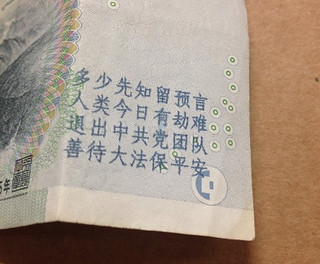 On a rainy day, after cowardly passing by ten times or so, I stepped into a Chinese acupuncturist’s office. Behind the counter, I found a man who was about 40 years old, sporting a white coat. I told him my story – that a restaurant in China wouldn’t accept my banknote and that I had no idea why. The man grabbed the note from me and analysed its front and back. Then he glared at me and threw the bill in my face. “This is not good,” he said. “This is a bad movement against the Chinese Communist Party. This is Falun Gong. This is not good at all.” That’s the only thing he would to say about it. Before it got too awkward, I quickly thanked him and ran out of the store.
On a rainy day, after cowardly passing by ten times or so, I stepped into a Chinese acupuncturist’s office. Behind the counter, I found a man who was about 40 years old, sporting a white coat. I told him my story – that a restaurant in China wouldn’t accept my banknote and that I had no idea why. The man grabbed the note from me and analysed its front and back. Then he glared at me and threw the bill in my face. “This is not good,” he said. “This is a bad movement against the Chinese Communist Party. This is Falun Gong. This is not good at all.” That’s the only thing he would to say about it. Before it got too awkward, I quickly thanked him and ran out of the store.
I finally found someone willing to openly discuss my strange Chinese currency – sinologist Stefan Landsberger from Leiden University translated the stamp on the bill in the following way:
How many prophets have warned
Humanity knows great decay
Retreat from the ranks and levels of the Chinese Communist Party
And wait for the moment till the Great Law will guard peace
The note that I intercepted was printed in 2005. It has, including the stamp, been able to circulate among the people of China for a maximum of nine years, without the CCP ever finding out about it. The most recent stamped bills were printed in 2011. I wonder if still, somewhere in a secret place in China, someone is stamping banknotes with Mao, a rose, a charming Chinese mountain scenery and a bold protest slogan.
To read the complete article, see:
I Have a Chinese Banknote That Everyone in China Is Scared of
(https://www.vice.com/en_uk/article/3b7bjb/i-have-a-chinese-banknote-everyone-in-china-is-scared-od)

WHY DON'T WE HAVE A $25 BILL?
A National Review article by Deroy Murdock published November 21, 2019 advocates for putting Harriet Tubman on a new $25 bill. -Editor
... some people want Andrew Jackson to stay on the $20 bill. While he is vilified these days for cruelly forcing some 20,000 Cherokee Indians down the deadly Trail of Tears, he also was the brilliant commander of the Battle of New Orleans, which kept Great Britain from corking the Mississippi River during the War of 1812. Had Jackson, the Free Men of Color, and his other racially integrated troops surrendered, Americans today might play cricket rather than baseball.
Most notoriously, the father of the modern Democratic party owned slaves. But if having at least one slave, even briefly, bars one’s face from U.S. currency, then it’s time to pry George Washington from the $1 bill, Thomas Jefferson from the $2, Ulysses S. Grant from the $50, and Ben Franklin from the Benjamin.
“I think Harriet Tubman is fantastic,” President Trump has said. “But I would love to leave Andrew Jackson or see if we can maybe come up with another denomination.”
Bingo!
Either Trump could upset Jackson supporters or disappoint Tubman fans. But rather than either/or, why not satisfy both?
Jackson should remain on the $20. And Tubman should stand on her own on a brand-new bill: The $25.
The $25 Tubman note “is a very reasonable compromise,” Lawrence W. Reed, president emeritus of the Foundation for Economic Education, told me.
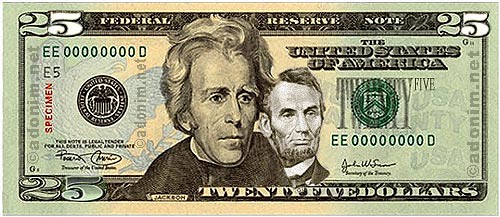
http://bitsandpieces.us/2010/10/26/25-dollar-bill/
So why is it that we have a $20 bill instead of a $25 bill, anyway? We have quarter dollars, but no quarter union. It's always bothered my anal retentive math and engineering soul that we divide the dollar in fourths but divide the hundred in fifths. What's up with that?
These things are often an accident of history, but when you dig into it sometimes there's a more practical explanation. Could it be that a $25 gold coin would have just been too large and heavy for practical use? Congress decides denominations, so everything we use today has been directed so by law. But has anyone researched just why lawmakers decided on a 20 vs. a 25?
We do indeed have (or rather "had") a 20 cent coin, but it was a short-lived failure because it was so close in size and denomination to the quarter. A new $25 note could meet the same fate, being so close to the $20. Interesting proposition, though. Regardless of the design, what do people think of the merits of a $25 bill? -Editor
To read the complete article, see:
Put Harriet Tubman on a New $25 Bill
(https://www.nationalreview.com/2019/11/put-harriet-tubman-on-a-new-25-bill/)

THE COLLECTING BUG: TYPEWRITERS, MICKEY MOUSE
Two stories on collecting in general caught my eye recently. The first is from a New York Times interview with actor Tom Hanks for his current film about Mister Rogers. -Editor
 So Tom Hanks is as nice as you think he is and exactly what you hope him to be, which is great unless you are someone trying to tell a good story about him, with elements like an arc and narrative tension. “Saintly Actor Playing Saintly Public Television Children’s Host Mister Rogers Is Saintly” is not a great story.
So Tom Hanks is as nice as you think he is and exactly what you hope him to be, which is great unless you are someone trying to tell a good story about him, with elements like an arc and narrative tension. “Saintly Actor Playing Saintly Public Television Children’s Host Mister Rogers Is Saintly” is not a great story.
Tom Hanks got his first typewriter when he was 19. He told me this at our second meeting, which was in Santa Fe, where he’s shooting “News of the World.” It was a Sunday, and he’d just come from seeing “Ad Astra” with his youngest son, Truman.
Hanks grew up in Northern California, in the era of the Zodiac Killer and Patty Hearst and the Black Panthers and the People’s Park riots. He was 5 when his parents divorced and he and his older brother and sister went to live with his father, while another brother lived with their mother. Both parents were in rough shape, just trying to survive. His father worked in a variety of small restaurants, remarrying again and again and moving every few months.
He and his siblings had the run of the house while their father worked long hours. They didn’t eat the frozen vegetables he brought home, and they mostly knew what time it was because of what was on television. “No one told me how to brush my teeth,” he said. “I never flossed until I was out of high school, because dental hygiene was handled by a filmstrip that we saw in second grade that said, really, try to eat an apple, and that cleans your teeth. So, hey, I had an apple last week, so my teeth are kind of clean.”
He remembers Oprah once asked him on her show about his dysfunctional family growing up, and he thought, “What’s that? Oh, that’s us.” He’d never thought of himself that way. But somewhere underneath he must have known that something was off because he had started accumulating a lot of typewriters. Hundreds of them. It was something about how he never got to keep the things he loved through all of his family’s moves. Now that he’s 63 and he’s thought a lot about it, he realizes that when he was young, he’d often have to move on a moment’s notice and was not in charge of packing, so he often lost things that were important to him. “I had nothing, actually, that stayed with me all through my life. I don’t have anything from when I was 5 years old. I don’t have anything from when I was 3.”
Like I said, he was 19 when he got his first typewriter. A friend gave it to him — “it was a hunk of junk — a toy,” he said. He went to get it serviced, and the repairman said to him, “This is a toy. Why are you using a toy?” The man sold him a Hermes 2000, which is now lost. So he invested in another. “I said, oh yeah, this is going to stay with me for a while, and I am soothed by it. I’m soothed by having it. I’m soothed by knowing that I can take it anywhere with me.”
To read the complete article, see:
This Tom Hanks Story Will Help You Feel Less Bad
(https://www.nytimes.com/2019/11/13/movies/tom-hanks-mister-rogers.html)
This piece from Yahoo! Lifestyle profiles a Mickey Mouse collector. -Editor
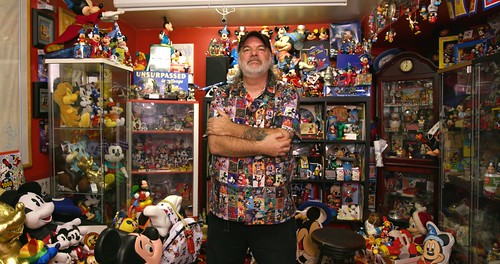
Paul Bottos didn’t have much of a childhood. He grew up in what he calls a “dysfunctional” family — constantly moving around, attending 17 different schools before even starting high school — and then wound up in group homes and foster care by the time he was 13. As a teen, he took part in a riot at his school and wound up spending six months in prison.
It wasn’t until connecting with Mickey Mouse that Bottos, of Hamilton, Ontario, in Canada, found himself “able to live a childhood I never had.” He was in his 20s at the time.
“My wife was collecting Beanie Babies, and I picked up this Mickey Mouse and thought, ‘Oh, it would be nice to have some more of these. I could start doing that,’” the recently retired manager of a psychiatric hospital for troubled youth tells Yahoo Lifestyle.
So Bottos started collecting and hasn’t stopped, now sharing space with nearly 10,000 items, from the 1930s through today — Funko Pops, tiny figurines, and a room full of hundreds of plush Mickey dolls. “I’ve probably spent $60,000 to $100,000 over my lifetime,” he says, also pointing out three Mickey Mouse-themed tattoos on his arms. “For me, this is my focus in life.”
When it was time to turn his life around, Bottos explains, that’s when he found the classic Disney character. “Mickey saved my life. I know he saved my life,” he says. “He’s made me a better person. I think a lot of times he gave me focus and something to look forward to, and it was always an adventure.”
To read the complete article, see:
'Mickey saved my life': Why this man can't stop collecting the Disney character
(https://www.yahoo.com/lifestyle/mickey-saved-my-life-why-this-man-cant-stop-collecting-the-disney-character-120434682.html)
THE BOOK BAZARRE
LOOSE CHANGE: NOVEMBER 24, 2019
Here are some additional items in the media this week that may be of interest. -Editor
Nicole Kidman: Coin Collector
Leading off this November 19, 2019 article from
 Kidman has an impressive coin collection that even includes a few ancient coins of Judea.
Kidman has an impressive coin collection that even includes a few ancient coins of Judea.
To read the complete article, see:
Celebrities with strange collections that may surprise you (21 Photos)
(https://thechive.com/2019/11/19/celebrities-with-strange-collections-that-may-surprise-you-21-photos/)
Woman Finds Bill Signed By Her Mother
This story from a Canadian newspaper recounts how a Nova Scotia woman found a banknote at a flea market with her own mother's signature on it. -Editor
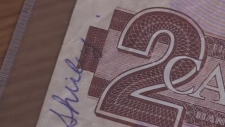 "When I looked down at the $2 bills, this name was on the bill," Wells said. "Shirley was on the bill."
"When I looked down at the $2 bills, this name was on the bill," Wells said. "Shirley was on the bill."
That got her attention because her late mother's name was Shirley.
She then studied the bill and said to Brennan.
"I think that's my mother's signature on a $2 bill," Brennan says.
Wells' mother has been dead for 12 years, but she recognized her handwriting right away.
"The emotions that came over me, I can't describe," Wells said. "My stomach did flip flops."
To read the complete article, see:
'My stomach did flip flops': N.S. woman finds late mother's signature on old bill
(https://atlantic.ctvnews.ca/my-stomach-did-flip-flops-n-s-woman-finds-late-mother-s-signature-on-old-bill-1.4691542)
NON-BANK FIRMS OFFER SAFE DEPOSIT SERVICES
So who's had to close and move a safe deposit box when their bank branch closed? This Bloomberg article discusses new businesses offering safe, trusted storage outside of traditional banks, -Editor
A few blocks from Grosvenor Square in Mayfair, 46 Park Lane resembles a private club with wood-paneled walls and an ornate fireplace dating back to Britain’s Victorian era.
But down a flight of stairs is one of the most secure rooms in London. Built by IBV International Vaults, the steel-walled stronghold is scheduled to open next month and will cater to billionaires looking for a place to stash their most prized possessions.
“We’re getting calls every week about a room available for 2.5 million pounds ($3.2 million) a year,” said Sean Hoey, managing director of IBV London, referring to an apartment-size space. The firm, which also has 550 safe-deposit boxes on site and room for about 450 more, is betting on London’s reputation as a “safe haven,” even with Brexit.
This will be IBV’s sixth location, and it’s hardly the only such firm fielding queries from the wealthy. From London to Switzerland to parts of the U.S., the rich are looking to store precious metals, cash and cryptocurrency. For some, it’s the threat of a global recession. Others are avoiding bank deposits as negative interest rates force lenders to charge for holding cash. Many are concerned about natural disasters.
“We’ve seen extraordinary demand for safe-deposit boxes ever since we started offering them in 2015, and that demand has really gone up since the late summer,” said Ludwig Karl, a spokesman for Swiss Gold Safe Ltd., which operates high-security alpine vaults. “Most people say they are planning for difficult economic circumstances.”
It’s a similar story for Sincona Trading AG, a precious-metals dealer with more than 1,000 safe-deposit boxes for rent in central Zurich. It had scores of empty boxes three years ago, but now it’s renting about five a day, said Benoit Schoeni, a managing director.
“There has been an extreme demand,” he said. “It won’t take too long until we’re full up.”
Safe-deposit boxes can range from a few centimeters in height to the size of a kitchen cabinet. Another option are free ports -- warehouses in tax-free zones such as Singapore, Geneva and Delaware favored for storing art, but which typically limit the amount of time that pieces can be held.
In the U.S., safe-deposit boxes also have largely fallen out of favor as banks close branches and opt not to install them in new ones. Demand has waned in recent years, according to JPMorgan Chase & Co. and Bank of America Corp., the nation’s two largest lenders.
“Much of the decline can be attributed to clients opting to store documents online, especially younger clients,” said Bank of America spokesman Don Vecchiarello.
This article validates a thought I've had for a while now. There is a market for safe storage outside of a traditional bank. My own local bank keeps closing branches. As a coin collector I've had a safe deposit box since I was old enough to sign the papers. What happens when the last branch closes? People like us will still want and need safe deposit protection for our collections. What do we do - just buy and install a home safe? It should be profitable to build up a business offering trusted, safe storage for valuables. I don't need a room, but I'm sure some people do. Just a deep box for me, thank you.
So I asked Dr. Google and it turns out a local ex-banker in my area already had that idea, opening Commonwealth Vault & Safe Deposit Co. five years ago. I added images from their web site. -Editor
To read the complete article, see:
World’s Rich Are Rattled and Seeking Old-Fashioned Security
(https://www.bloomberg.com/news/articles/2019-11-20/world-s-rich-are-rattled-and-looking-for-old-fashioned-security?srnd=premium)
To visit the Commonwealth Vault & Safe Deposit Co. site, see:
https://www.commonwealthsafebox.com/index.html

